The Story of Edgeware Outdoor UPS Enclosure for Video Surveillance
- Richard Wang
- December 15, 2021
- 10:31 pm
Content
1.Typical Video Surveillance Power Supply with Outdoor UPS
2.Our Development History-From Outdoor Power Cabinet to All in One Outdoor UPS
2.1 -Outdoor Power Cabinet-Mysterious Big Guy
2.2 Miniaturized Outdoor UPS-The little guy who basically meets the requirements
3. Experience and Summary
3.1 Commonality of Video Surveillance UPS Cabinet-Outdoor Edge Network Node
3.2 What Causes the Complexity of Outdoor Edge Network Node?
3.3 Decoupling, Figure Out What is Changing and What is Unchanged
4. Products Derived from Experience Summaries-All in One Modular UPS Cabinet
4.1 Edge Equation Lite series- Modular Outdoor UPS Cabinet Design Concept
4.2 Architecture of Edge Equation Lite series
4.3 Examples of Typical Applications
4.4 Advantages of Edge Equation Lite Modular Outdoor UPS Cabinet
5.Upgrade Again-IP65 All in One Outdoor UPS Embedded with Network Modules
5.1 Development Background of Edge Span Series
5.2 Design Concept of Edge Span Series
5.3 Architecture of Edge Span U Series All in One Outdoor UPS
5.4 Edge Span Series Advantages
6.Summary
1. Typical Video Surveillance Scenario Model with Outdoor UPS
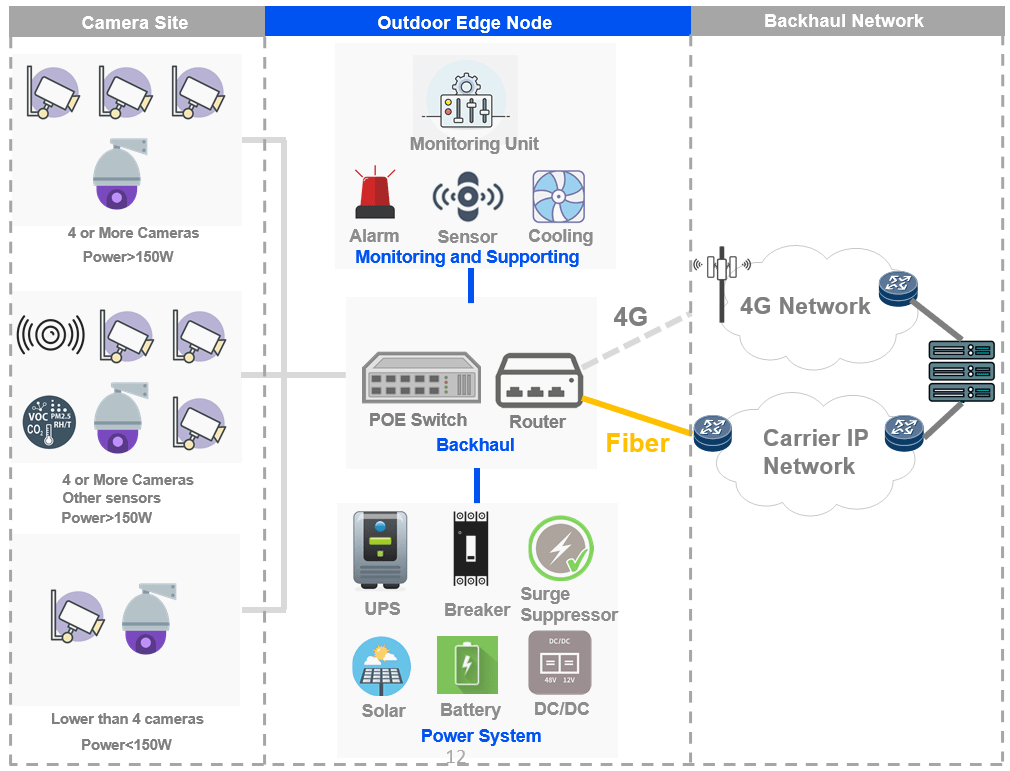
The application of video surveillance is quite extensive. If we simplify the model of video surveillance, we can get the simple model shown in the figure above. Based on the model of this scenario, Edgeware has developed a full set of All in One Outdoor UPS. This process lasted for four years, and today I will tell you the story and experience of our journey along the way.
Before telling this story, I would like to thank customers in Central America and the Caribbean, such as Digicel, Cable Wireless, Altice and other operator customers, and government customers such as Panama Meduca for their valuable suggestions. Your suggestion is the direction of the development. At the same time, I would also like to thank my colleagues for their unremitting efforts, so that we can be customer-centric and upgrade our unique products. It is a great honor to work with you:.
Names not listed in order:
Edgar Luna, ISIS Torres, Ivan Herrera, Felipe Gonzalez, Jorge Reyes
2.Our Development History-From Outdoor Power Cabinet to All in One Outdoor UPS
2.1. Mysterious Big Guy
Four years ago, customers in Latin America wanted us to design a outdoor UPS enclosure for them to provide backhaul and backup power to the outdoor video surveillance network. Under the general perception, we will use an outdoor cabinet to deal with this kind of scenario. The usual idea is:
(1)Outdoor deployment
Use outdoor cabinets, whether large or small, just meet the functional requirements
(2)Backup power: UPS + battery
There are many options in the UPS and battery market, and we can help customers integrate them.
(3)Backhaul Network + camera power supply:
Use our company’s own POE switch to complete the task.
I have to say that newborn calves are not afraid of tigers. Under the recognition at the time, we made the first version of the design. As you can imagine, based on the choices on the market at the time, we chose a 19-inch rack-mounted UPS and lead-acid batteries. Then put in the POE switch, ONT and other equipment. Of course, there are also protective devices such as power surge suppressor, breakers, and network surge suppressor. The functions are complete, but we discovered that we have created such a monster:
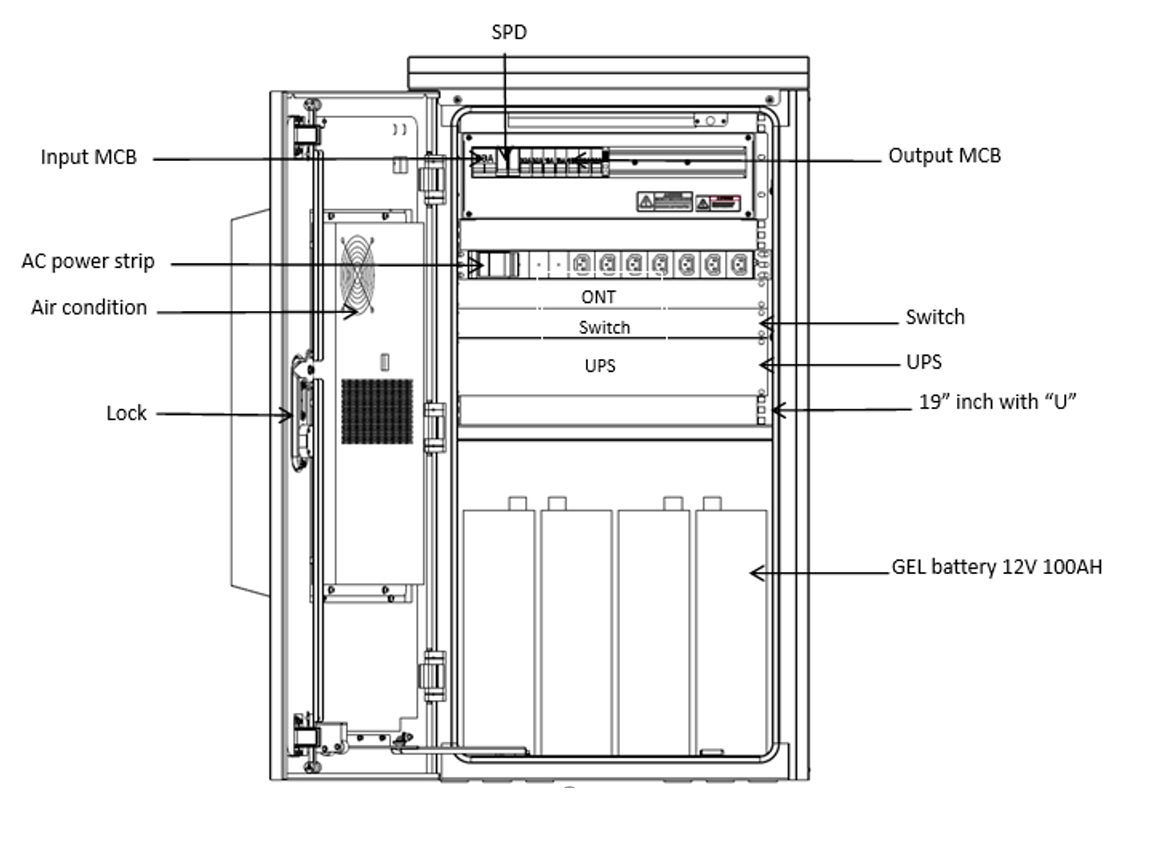
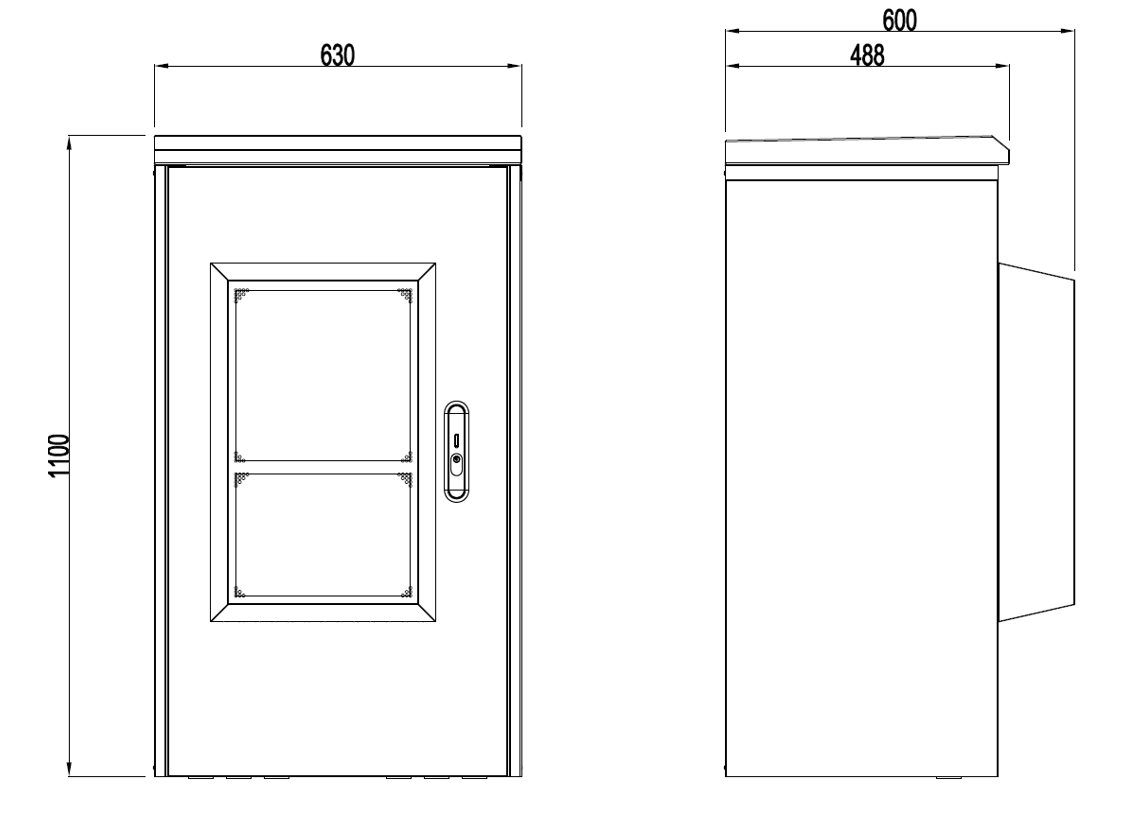
Isn’t it funny? In other words, there are 4-6 cameras per POLE, making such a huge custom power enclosure. So is the customer deploying a video surveillance network or is it deploying an outdoor cabinet? Don’t forget that the cabinet is just an accessory device of the video surveillance network. Of course, the customer’s backup time and some design requirements are also one of the reasons that make this design so funny. So many years have passed, and now in retrospect, neither we nor the client knew how to design such a project.
Take a look at the finished product we made at the time,a huge outdoor ip55 power enclosure:
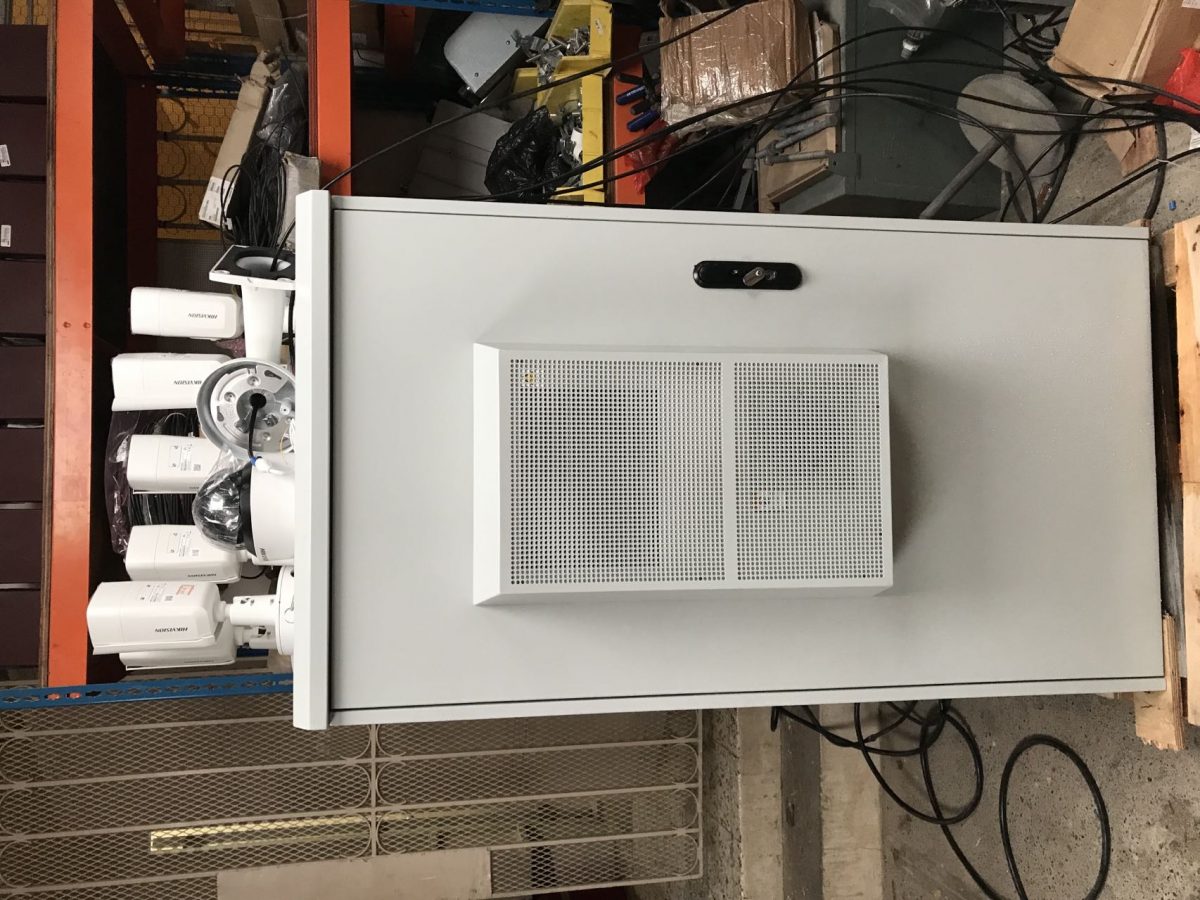
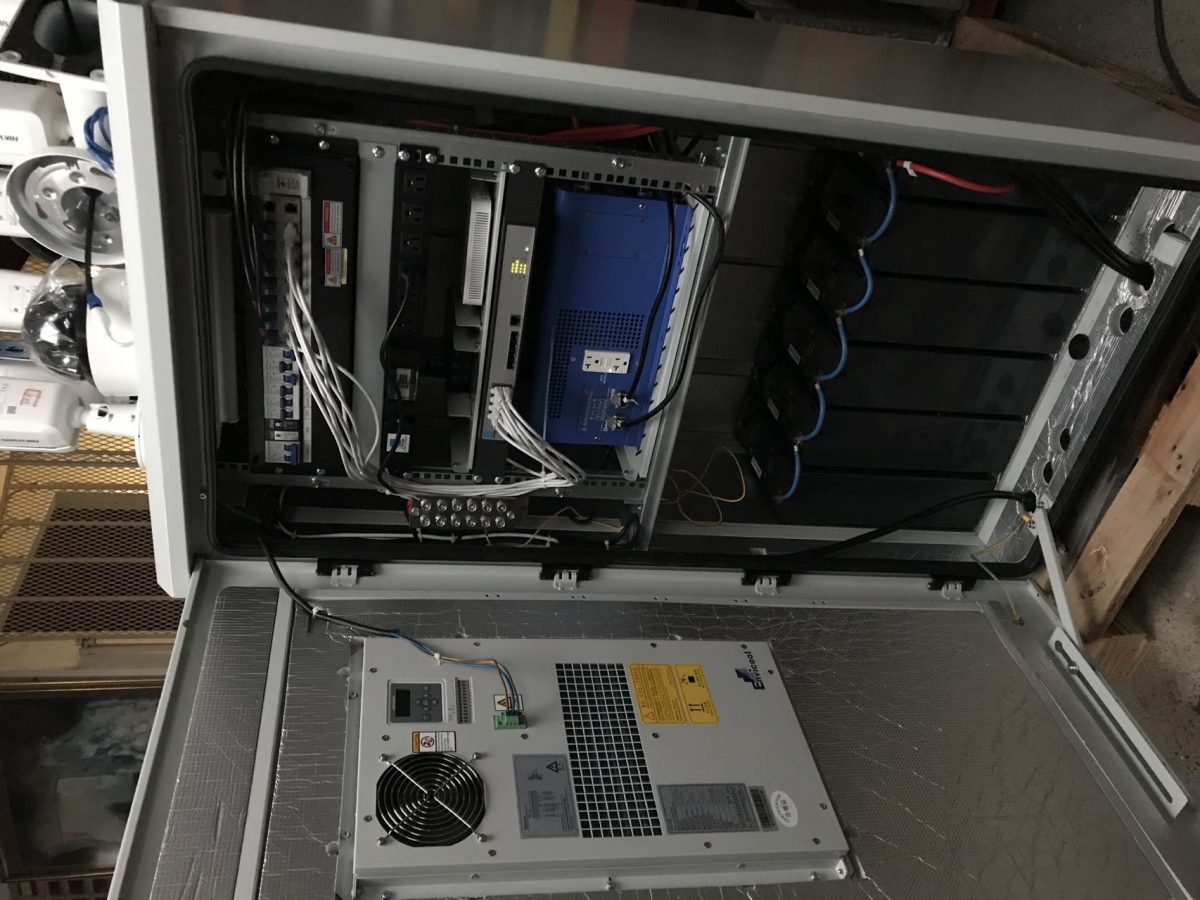
You can imagine the cost of installation and maintenance in the future. And to make matters worse, this is to be installed on a pole.
Let us reflect on why the entire design becomes like this:
- This outdoor UPS system is not miniaturized. In fact, we can imagine that with 4-6 cameras + switches and other network backhaul devices, the power consumption of the entire system will not exceed 150W. Considering battery charging, the power of 200-300W is sufficient for the whole system. However, the most common ones in the market are 1KVA, 2KVA 19-inch rack-mounted 2U 3U. The UPS is so big, the width of the cabinet is at least 19 inches rack-mounted
- The use of lead-acid batteries has brought a series of chain reactions. First of all, lead-acid batteries are large and heavy. Naturally increase the volume of the outdoor power cabinet. But the most deadly factor is that the working temperature of lead-acid batteries is 25°C. Our project is deployed in Central America, where the temperature is higher than 25°C throughout the year. If only fans are used for heat dissipation, it is conceivable that the outdoor ups cabinet temperature will reach 25°C or higher at noon. So we use air conditioners to cool down. When you use air conditioners, it brings extra power consumption and has to increase the battery capacity. Of course you will think that many systems on the market are deployed using lead-acid batteries and fan-style cabinets. The disadvantage of this design is that when you deploy a large-scale video surveillance network with a large number of sites, it is conceivable that lead-acid batteries will fail prematurely due to temperature, and the maintenance cost of replacing batteries will be high.
- The network, UPS, battery, remote monitoring system, and various protection functions are all designed separately. Some of them are our products, and some are purchased from suppliers. They are a patchwork system.
So we thought about whether it could be optimized to make the outdoor UPS cabinet more integrated.
2.2. The little guy who basically meets the requirements
A regional operator asked us to provide their PTZ camera pole with an overall solution for backhaul and Outdoor Power Backup. This time we fully absorbed the previous experience and provided a more integrated outdoor UPS solution. Of course, this time the camera is a 60W PTZ camera. The power requirements are not so high, and the design is easy to miniaturize. Our main idea this time is:
- Outdoor UPS miniaturization
After the UPS is miniaturized, the standard 1KVA 19-inch rack-mounted UPS can be avoided, so that the cabinet does not need to adopt a 19-inch rack compatible design, thereby greatly reducing the width of the cabinet. Because it is miniaturized, it can be easily become wall mount UPS or pole mount UPS.
- Use lithium battery
The operating temperature of the lithium battery can reach 45°C, so that the fan can meet the requirements for heat dissipation and avoid the use of air conditioners. So the design became lithium battery cabinet.


Let’s take a look at the internal design:
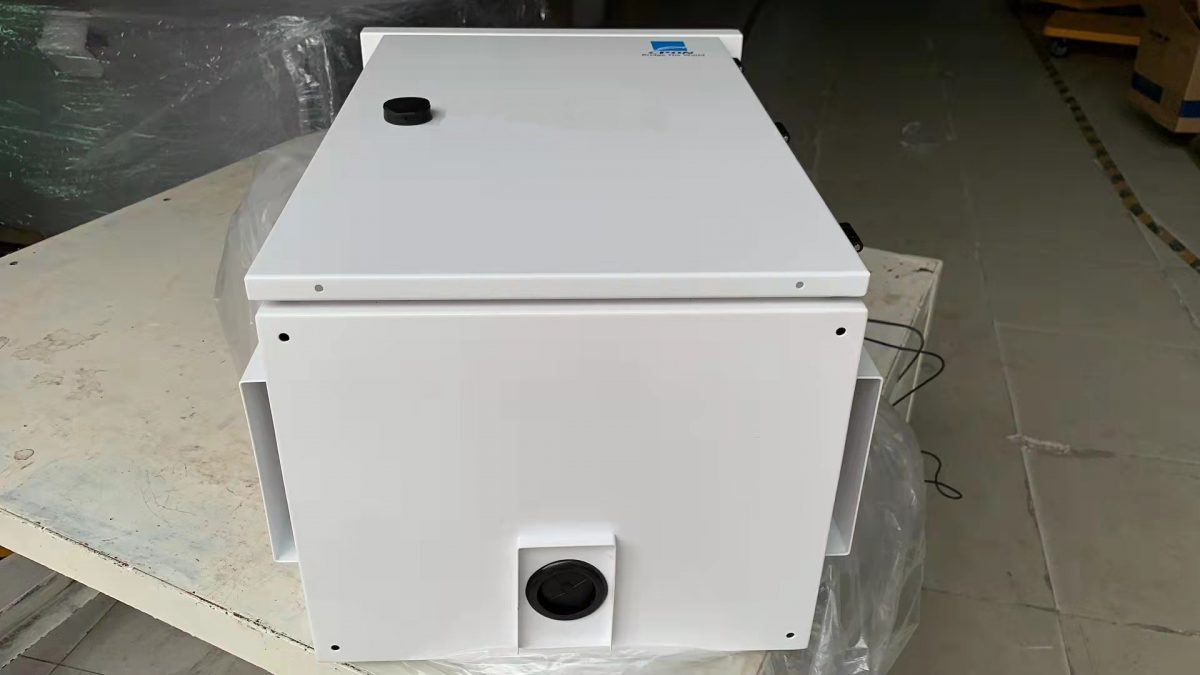
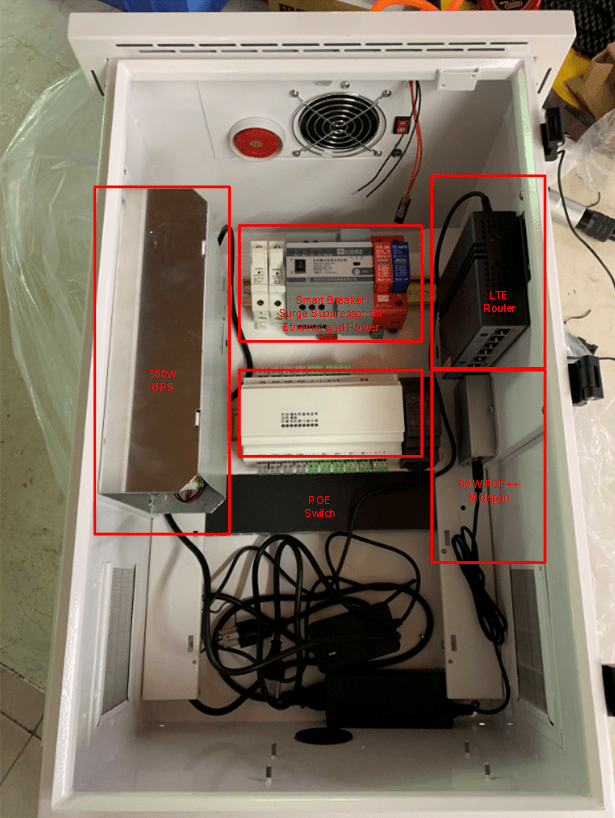
This design is still in the Stone Age relative to our new generation products. But compared to the huge outdoor UPS cabinet of the first version, it is more compact and more suitable for the deployment of video surveillance networks. But in actual operation, we found the following problems:
- Our company’s POE switch is too large to be installed in a reduced cabinet frontally, and can only be installed against the back of the cabinet, which is extremely inconvenient for installation and maintenance.
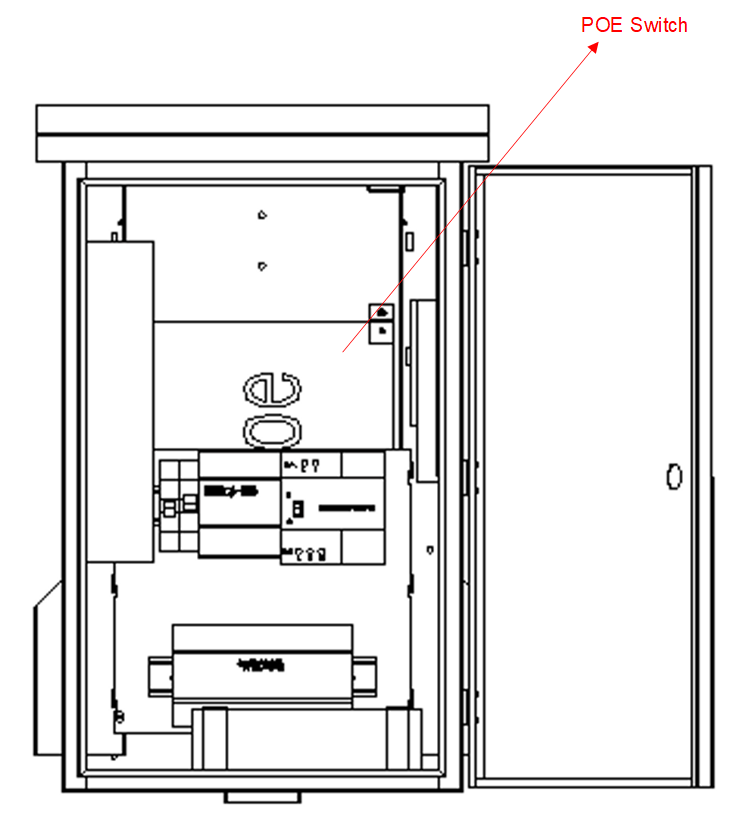
So we reflected on whether it is possible to miniaturize POE?
- When the whole system is connected, the internal cables are complicated. Various wiring logics are not optimized enough.
- The cabinet material is galvanized steel, which is not suitable for Central America and the Caribbean. Central America has high humidity and high temperatures. There are many sea areas in the Caribbean, with high humidity and high salinity in the air. These factors make high-quality galvanized steel easy to rust in this area.
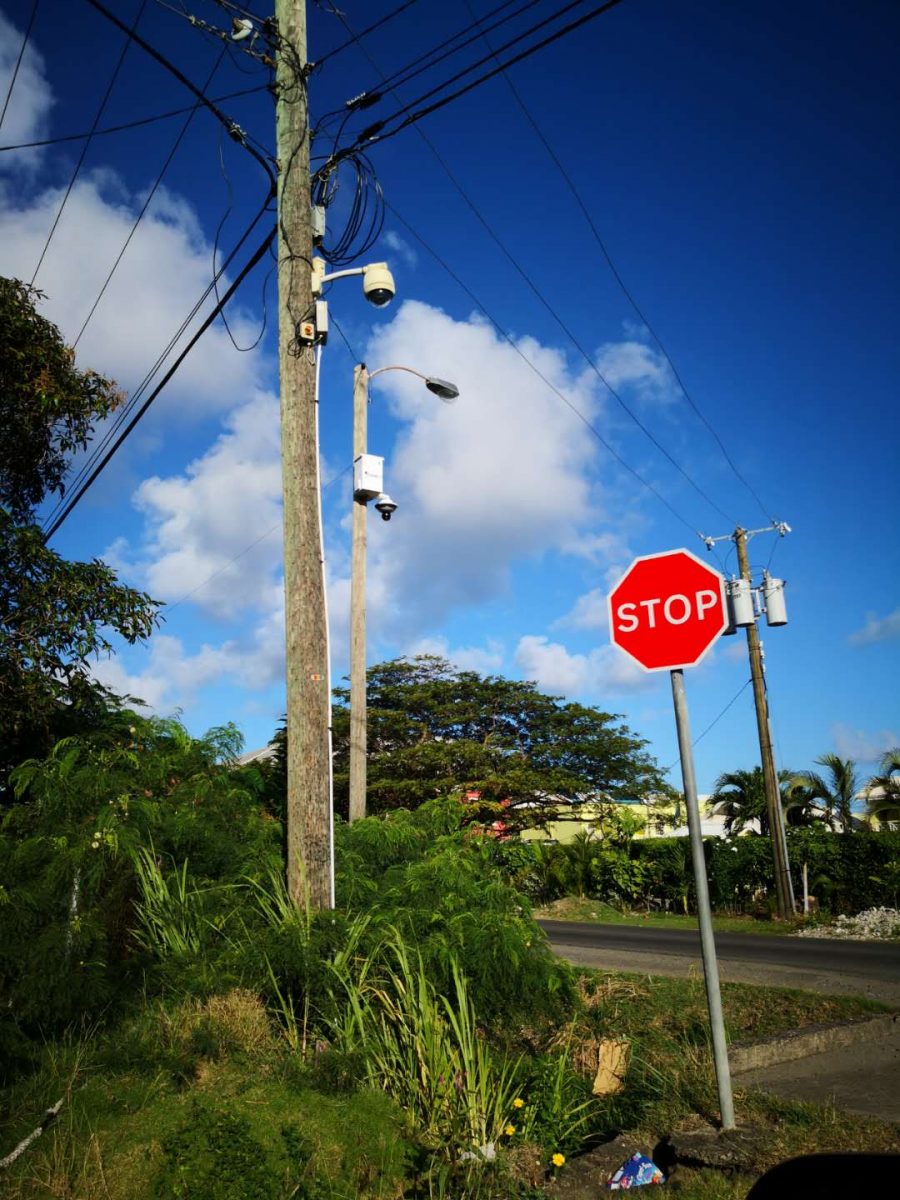
In the end, the site was successfully deployed, which was much easier than in the Stone Age, but we also got clues to continue optimization from the project.
2.3. Quasi All in One Design-VBM-G4 Version
With the help of the previous version’s experience, we have designed an improved version for our customers. Following the experience of previous projects, the main directions of our improvement:
- The problem of excessively large POE switches has been reviewed repeatedly, and we believe that the outdoor UPS cabinet should be designed as a small rack. However, due to time and project constraints, it was not implemented in this version.
- Upgrade the material to 304 stainless steel to solve the rust problem caused by the special environment in Central America and the Caribbean.
- Optimized equipment arrangement and connection logic, integrated structural design.
This version we named it VBM-G4 version Quasi All in One Outdoor UPS
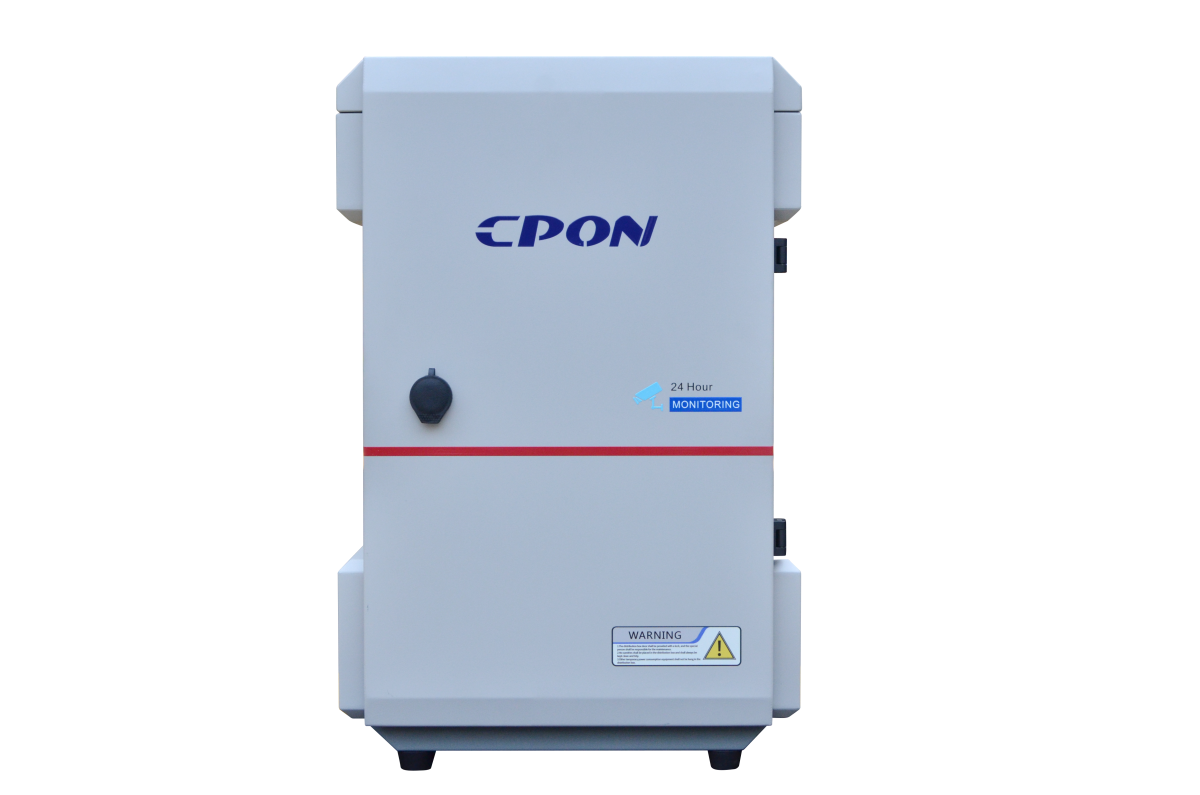
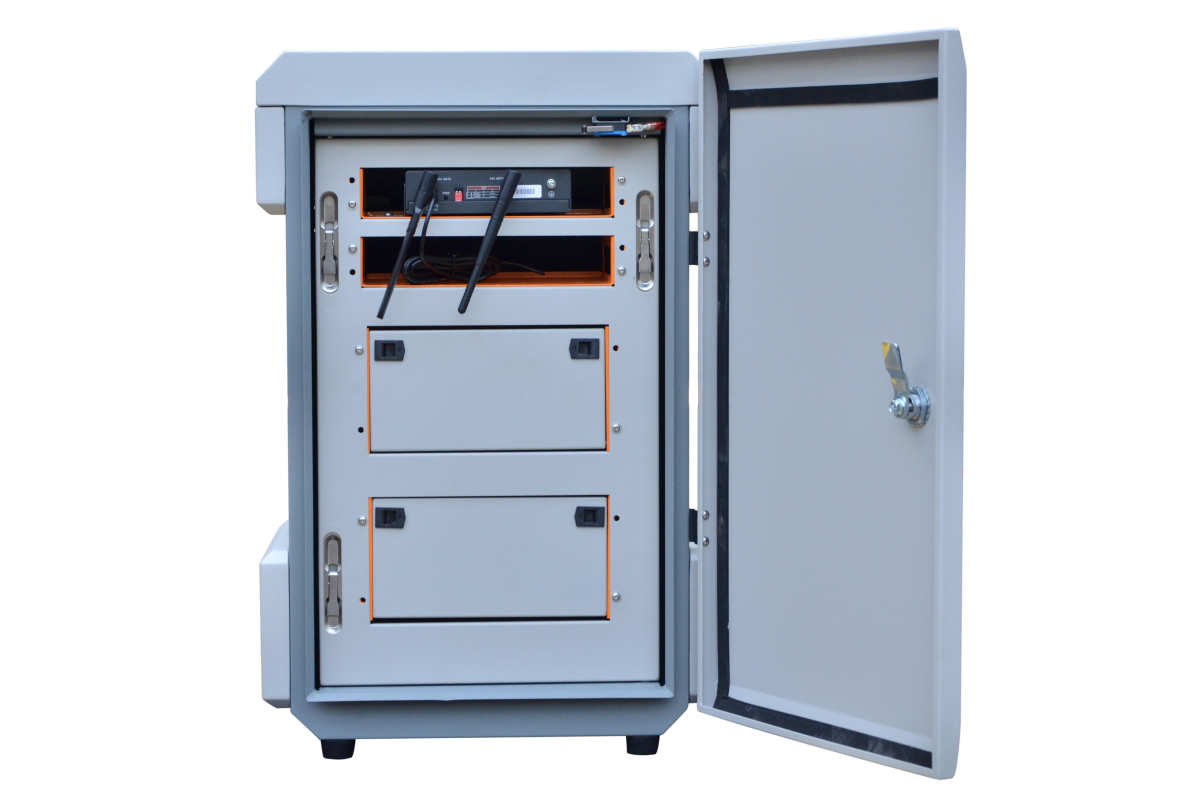
It can be seen that compared with the previous version, the planning layout of this version is more reasonable. The use of space takes into account the habits of actual use. Although the problem of the switch is too large, it has not been solved. But the overall development has been towards the direction of All in One. This version has been verified in Cable Wireless, Digicel and other government projects. Compared with the previous version, it has been greatly improved.
However, in use, we still found that the points that need to be improved are as follows:
- The switch is too large and has to be installed on the back of the cabinet, which is inconvenient to use.
- In terms of space, although the distribution of equipment has been rationalized, there are still complicated interconnection problems in terms of usage habits and equipment interconnection. Especially when the device arrives at the site, it is very painful to debug, because the logical relationship of cable interconnection is too complicated.
- The outdoor UPS cabinet is still not Plug and Play, and installation at the station still takes a lot of time. In many countries, labor costs are high, leading to high installation costs.
- The structure of this model is not strong enough, which often leads to the problem that some parts need to be re-reinforced after the goods arrive from international transportation. This directly leads to higher local maintenance costs for Edgeware.
3. Experience and Summary
3.1. Commonality of Video Surveillance Scenario-Outdoor Edge Network Node
In 2020, after so many previous versions and so many years of exploration and iteration, we want to stop and sum up the experience and lessons.
The node of the video surveillance network is essentially a node of the edge network. In fact, many outdoor edge network deployments have similarities.
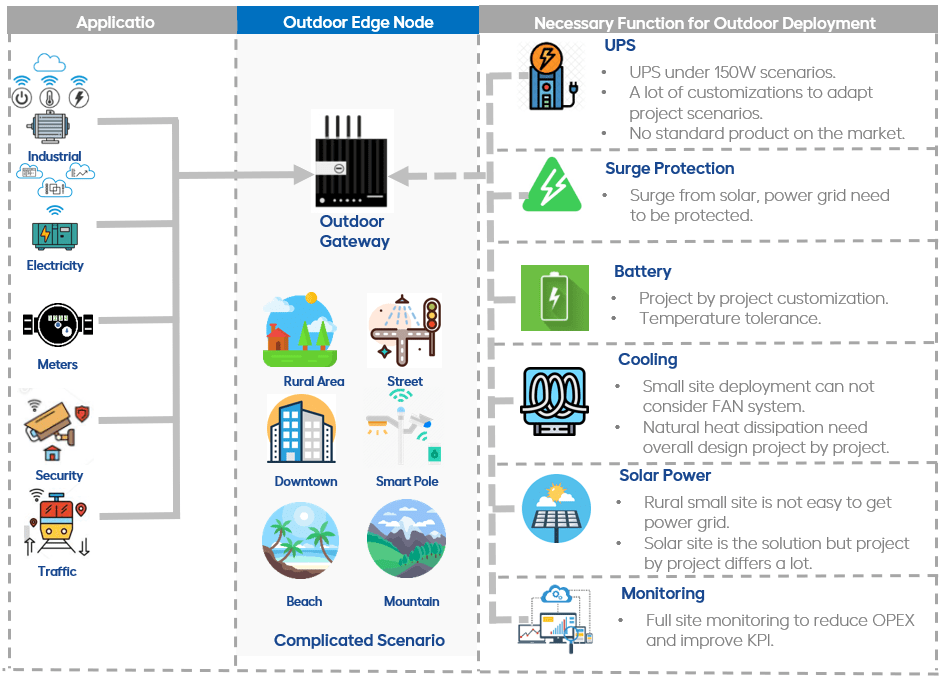
In fact, the location of the video surveillance network appears in many other applications. For example, the SCADA system of electric power needs to upload control signals such as RS485, DI, and DO to the headquarters. Another example is industrial control scenarios, smart water meter data return, smart transportation, IoT and other scenarios. We will all come across this outdoor edge playing node. They have the following commonalities:
- Complex outdoor deployment environment
- The application scenarios have changed a lot, and the degree of customization is high
- Although the node is small but functions are complete, improper construction will lead to high maintenance costs
- In the power grid scenario, UPS and battery backup are inevitable
- Lightning protection is also necessary
- For the stability of the equipment system, the correct heat dissipation design must be considered
- To reduce OPEX during large-scale deployment, system monitoring must be considered
3.2. What Causes the Complexity of Edge Network Node?
In fact, in the 2019 version of VBM-G4, we are already a lot ahead of other competitor in the market. The reason for the lead is because we provide a one-stop solution. From the structure design of the outdoor cabinet, heat dissipation design, UPS, battery, backhaul network, monitoring and maintenance system. It is a quasi All in One system. Although it is an All in One system, we can customize and change it according to customer needs.
Let us look at a typical situation in the market:
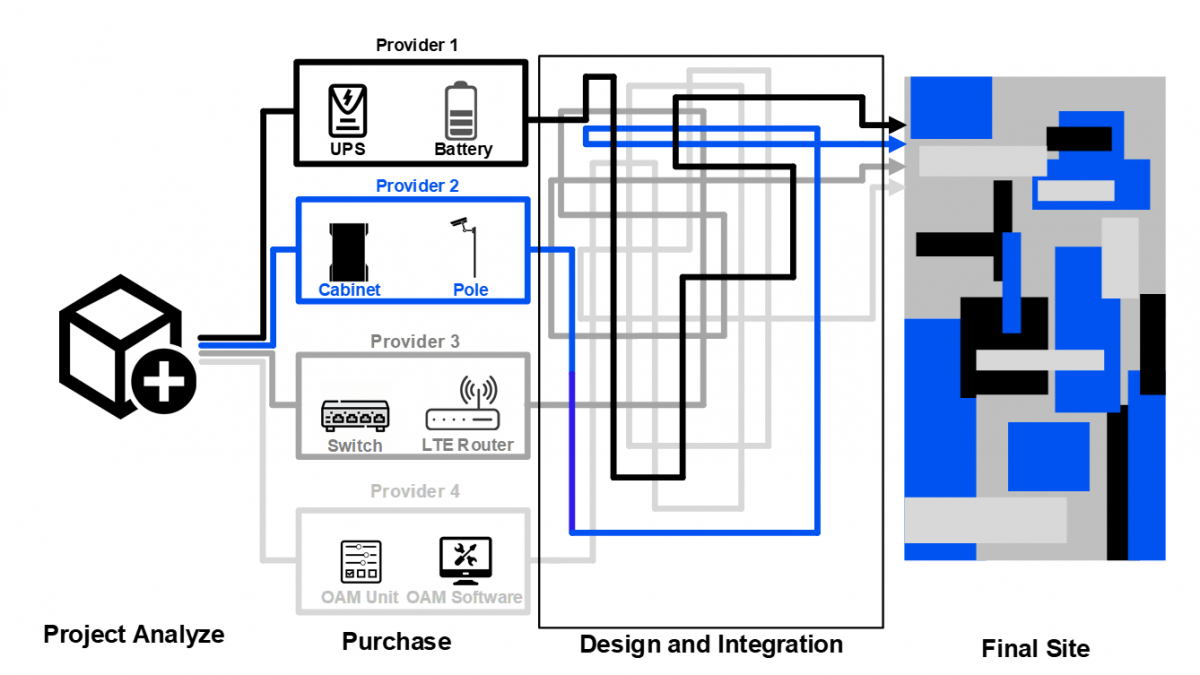
This is a typical design process for outdoor edge sites. No manufacturer in the market can provide customers with one-stop service. So customers have to consider the overall design themselves. Due to its small and complete characteristics, outdoor edge network nodes have high requirements on the designer’s network, power supply, structure, and maintenance knowledge. Customers may not have experience in the entire field, and design often has problems. Therefore, when the client work on the edge of the outdoor design, it was like walking through a maze. The final design of the puzzle is uncertain whether the function can be realized. The customer bears all the risks. The typical problems we found are as follows:
Manufacturers on the market only consider the standardization of their products and no one considers the entire system
For example, is the standardized 19-inch rack-mounted UPS like the following really suitable for deployment in edge networks? You only need 300W, but these 1KVA-level devices are on the market, so you have to replace them, resulting in a much larger system.
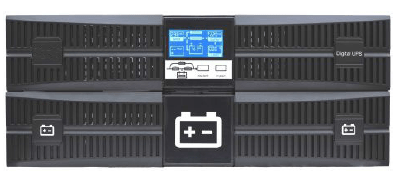
For example, switches and routers are in the following form:

In order to put down these boxes, how much did you pay extra? Why can’t it be designed as One Stop ,All in One
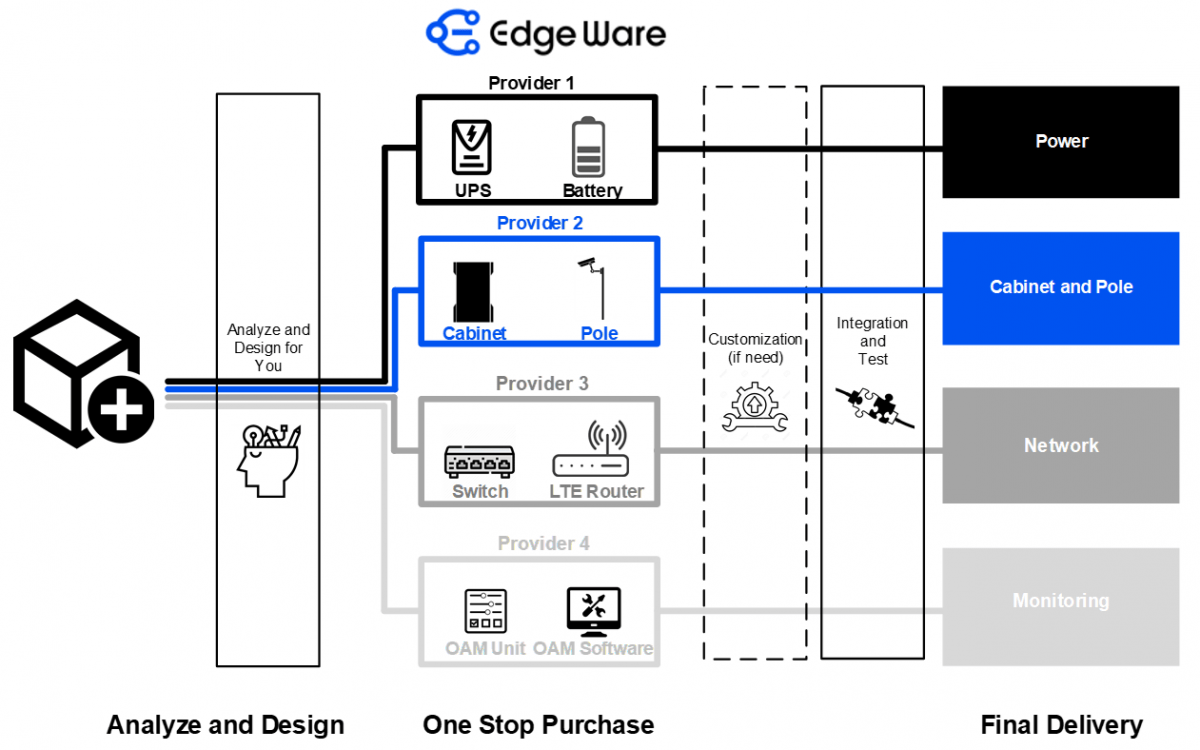
Edgeware has the ability to provide customers with one-stop service. Starting from the scenario, the four perspectives of power, structure, return, monitoring and maintenance are one-stop design. And according to the customer’s scenario for customization, integration and testing. One-stop delivery of the final product to the customer.
3.3. Decoupling, Figure Out What is Changing and What is Unchanged
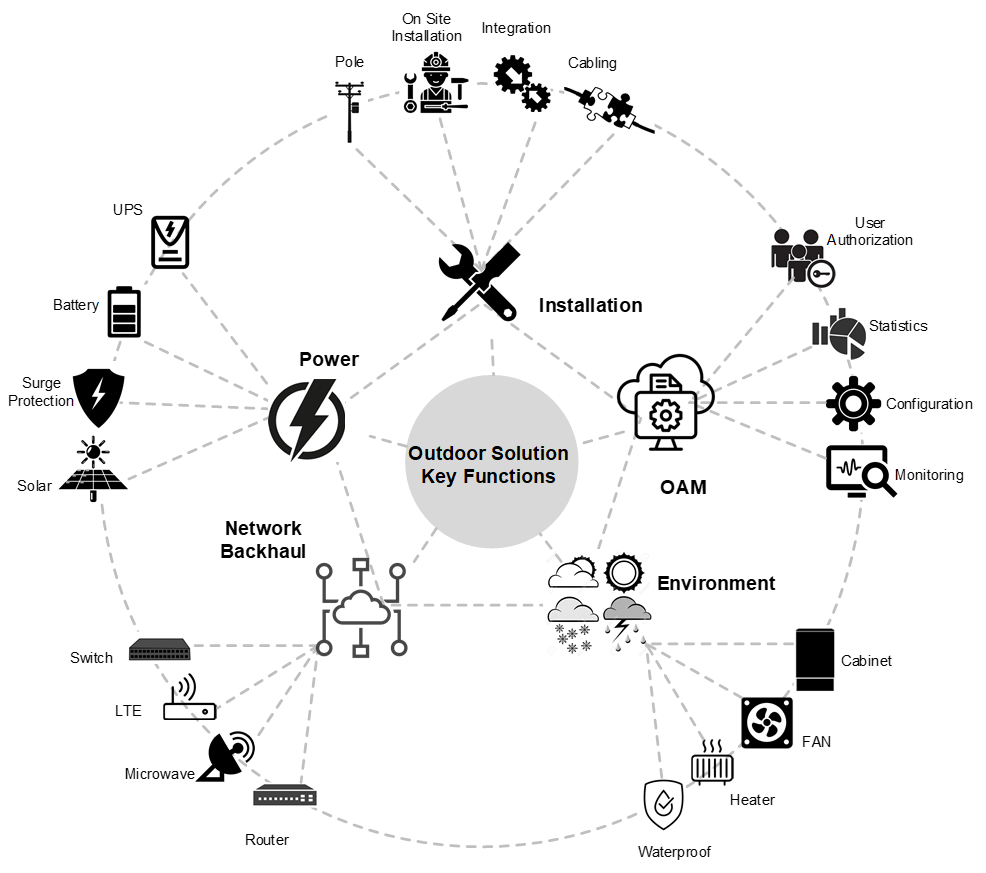
As shown in the figure above, we will find that there are too many aspects that need to be taken into consideration coupled with each other. In fact, if we do a careful analysis, we will find that some change frequently, while some can remain relatively stable.
- What has changed is the application and the network
In fact, in the deployment on the edge network, the application and the network are changeable. For example, the number cameras will be different, the backhaul network is different, sometimes with optical fiber, sometimes with LTE, and sometimes with wireless P2P or P2MP. they largely affect the stability of the entire system design.
- Power and protection are relatively stable
For the power system and overall protection, the demand has always been relatively stable. For services at outdoor edge nodes, such as WIFI, video surveillance, IoT, etc., the overall power consumption is generally not higher than 300W.
In terms of protection, power-related protections such as lightning surge protection, overvoltage and undervoltage protection, overcurrent protection, and short circuit protection have always been relatively fixed.
- The monitoring system needs to change with demand
When outdoor edge nodes are deployed on a large scale, the monitoring system is very important. Because these nodes are large in number and widely deployed, if there is no reliable monitoring system to monitor the running status of the entire system, the maintenance work will be extremely complicated. Every time a problem is located, it is necessary to arrive at the station, which greatly increases OPEX. But because the application is changing, so the monitoring system needs to change as the application scenario changes.
4.1. Edge Equation Lite series- Modular Outdoor UPS Cabinet Design Concept
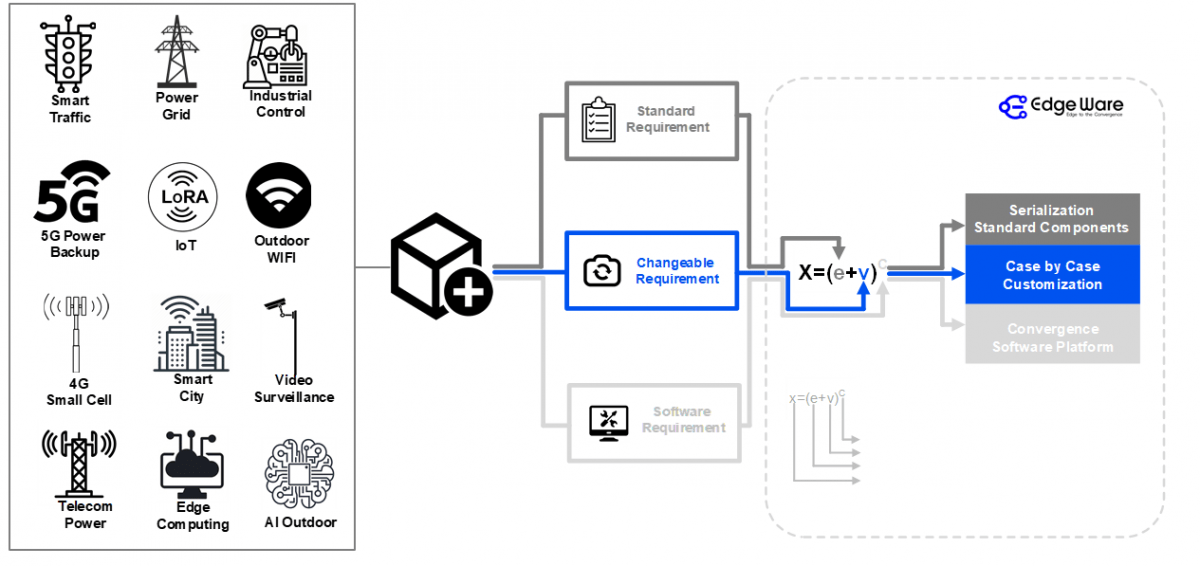
It can be concluded from our previous experience that if we analyze the design of outdoor edge nodes and decouple the system, we will find that the network and applications changed case by case, while the power system has not changed much. Therefore, we split the system into:
- Standard Requirement – e
As we have summarized, the power system is generally relatively stable. The power consumption of the scenario we face will not be higher than 300W, so we customized the UPS system suitable for this scenario, miniaturized and standardized it. At the same time integrated lightning protection, smart breaker and other functions. Since it is a stable and unchanging factor, similar to Euler’s Number in scientific notation, we call it
e
- Changeable Requirement –variable
Network and application are similar to a variable, which changes greatly with different projects, we define it as variable
v
- Software and Monitoring–c
Edgeware has our own monitoring software platform-Edgeware Convergence Software Platform. The name comes from our company’s Mission, which is converges of edge networks.
Thus we come to the design concept of our modular outdoor edge node cabinet
x=(e+v)C
x is our outdoor edge node. Through the stable factor e plus the variable v and finally add our convergence software to achieve a more stable architecture to cover more types of business.
4.2. Architecture of Edge Equation Lite series
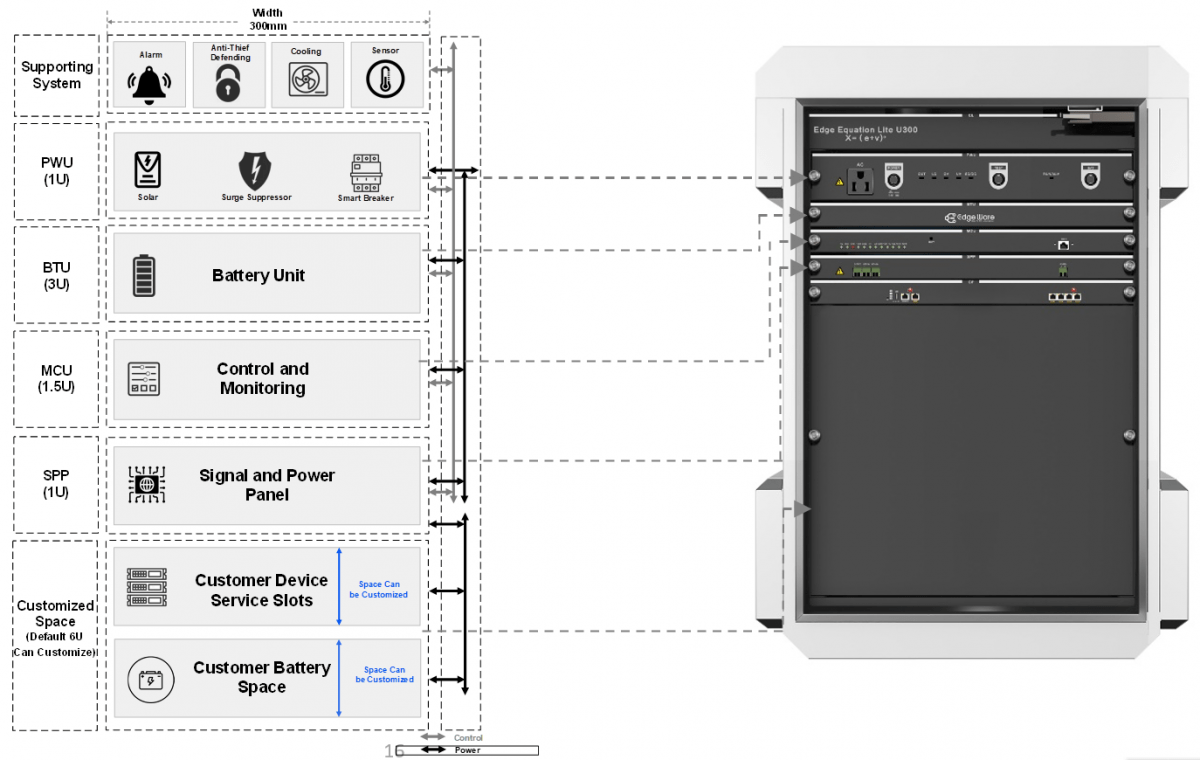
Edge Equation Lite learns the idea of ATCA architecture and divides the whole system into different slots. Among them, PWU, BTU, and MCU are relatively fixed units, while Customer Device Service Slots and Customer Battery Space can be customized and can be expanded or reduced according to customer requirements. The explanation of the different functional units is as follows:
- PWU as Power Unit provides the 300W ups power as well as surge protection, short circuit protection functions.
- BTU as Battery Unit provides backup battery power to the system. Default configuration is 48V10AH or 48V15.6AH lithium battery. We also provide customization services to enlarge the battery while meanwhile BTU will occupy more space.
- MCU is the control and monitoring unit provides the monitoring for the whole cabinet system. This unit will communicate with Edgeware Convergence Platform to provide remote monitoring and management functions.
- SPP is the slot that provide the interconnection of the whole system.
- CSS as Customer Device Service Slots provides the space for your devices that will install in our cabinet. This space is changeable based on your request.
Through this design, the design of the power supply is relatively stable. CSS is the space for network equipment and application equipment. The relationship between the power supply system and the network equipment is all interconnected through the SPP slot. In this way, the power supply and the network application are decoupled.
4.3. Examples of Typical Applications
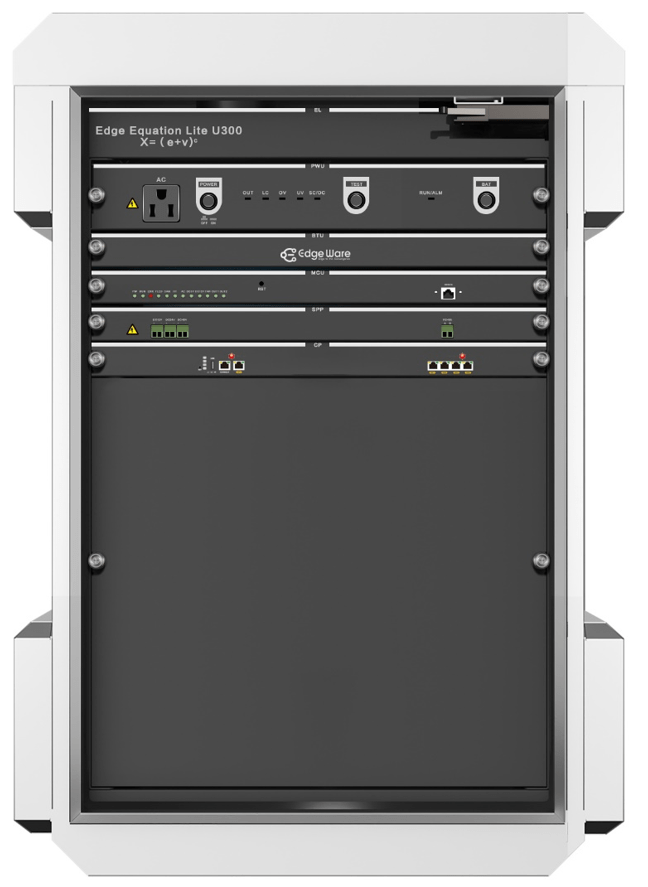
Scenario 1 :Outdoor WIFI AP Power Cabinet
* PWU,BTU,MCU,SPP configured.
* BTU with 48V10AH battery can keep whole system run 2.5 hours(200W load).
* Layer 3 Router with 4 ports POE/POE+/POE++
* Perfect outdoor WIFI power and backhaul node
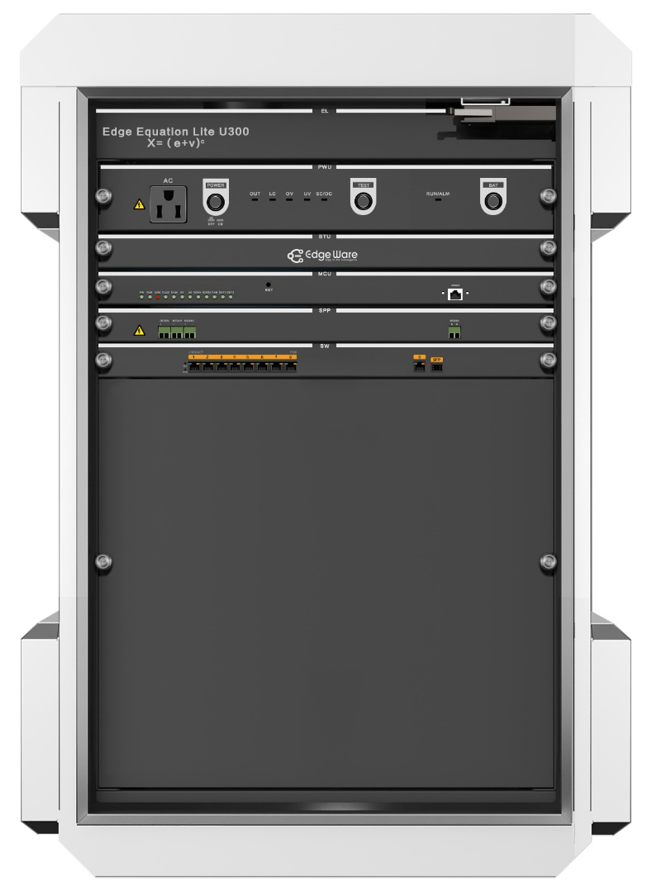
Scenario 2 :Outdoor Video Surveillance Power Cabinet
* PWU,BTU,MCU,SPP configured.
* BTU with 48V10AH battery can keep whole system run 2.5 hours(200W load).
* Layer 2 switch with 4-8 ports POE/POE+/POE++.
* One stop outdoor power and backhaul node for video surveillance.
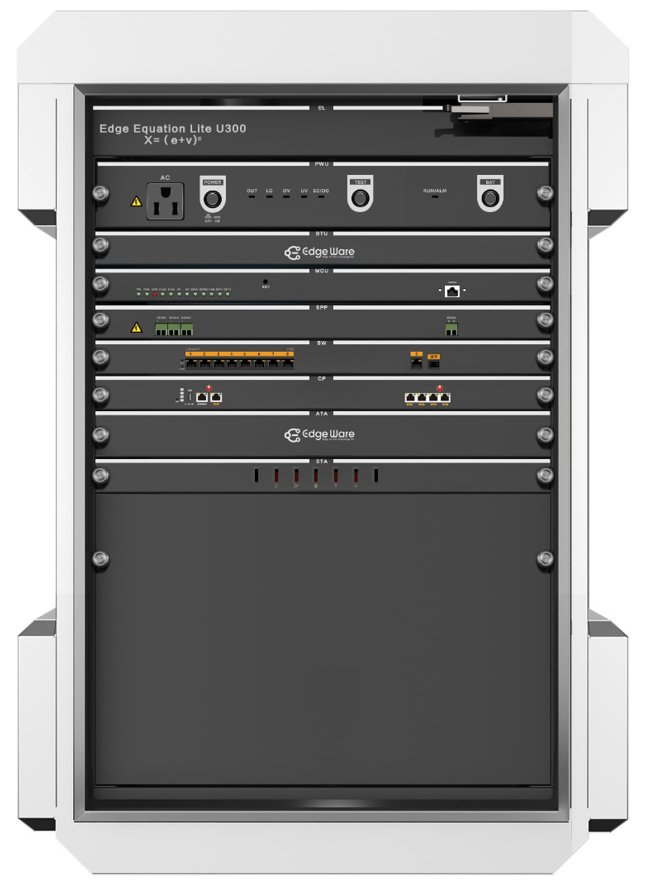
Scenario 3 :Outdoor Satellite Site Power Cabinet(Lithium Battery)
* PWU,BTU,MCU,SPP configured.
* BTU with 48V10AH battery can keep whole system run 2.5 hours(200W load). Can be configured bigger battery.
* Layer 3 router
* Satellite router
* PBX
* All in one remote telecom coverage node.
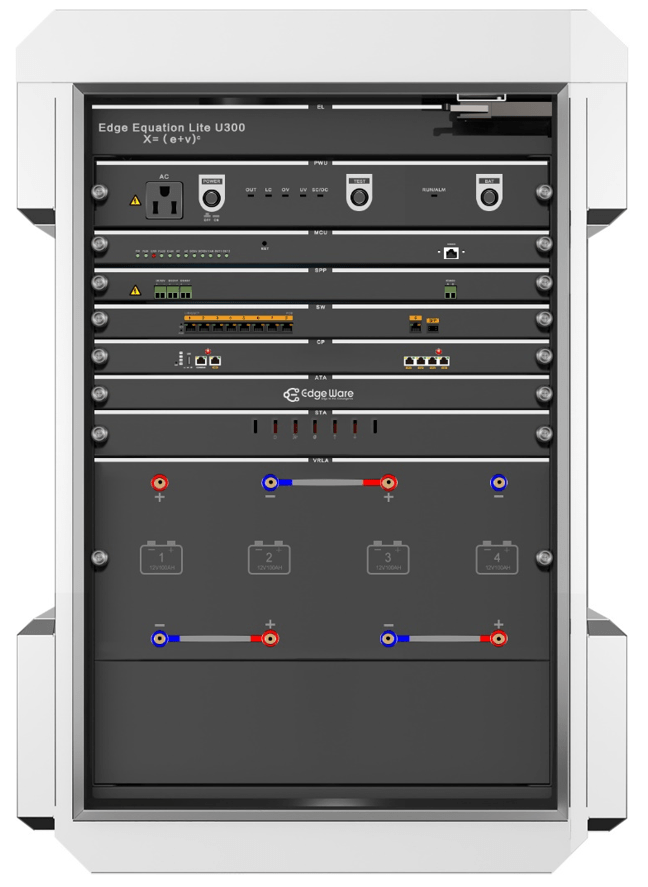
Scenario 4:Outdoor Satellite Site Power Cabinet(Lead Acid Battery)
* PWU,MCU,SPP configured.
* Lead acid battery
* Layer 3 router
* Satellite router
* PBX
* Cost down all in one remote telecom coverage node.
4.4. Advantages of Edge Equation Lite
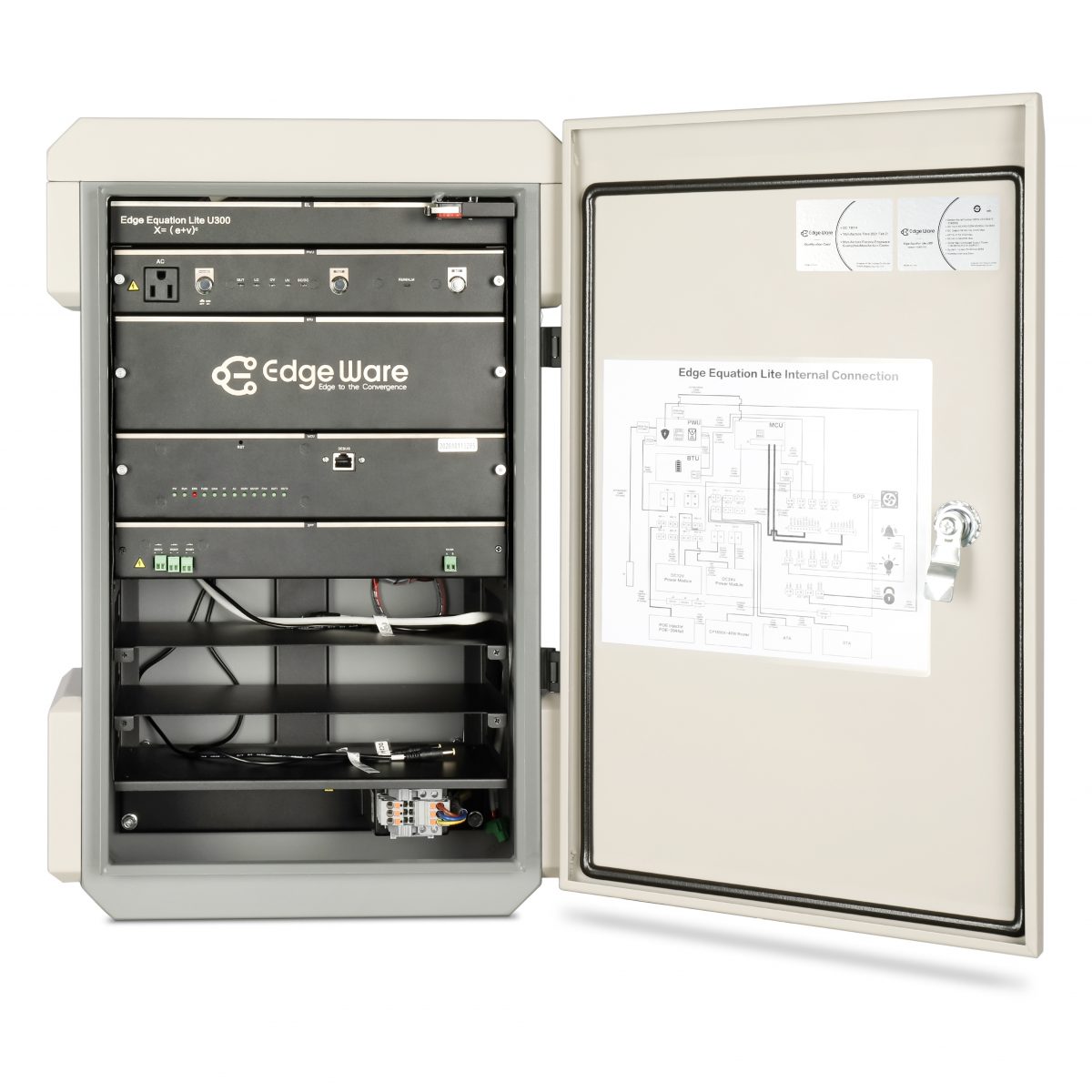
The Edge Equation Lite series has been verified by a large number of outdoor deployments and has been well received by customers. The advantages are summarized as follows:
- Maximum space usage efficiency, at least 30% smaller than competitors’ cabinets in the same scenario,
- The maintenance of the power supply are fixed, no matter how the network application changes, it will not affect the system architecture.
- Application and network equipment power supply cables is completed before shipping
- Plug and plug are implemented, and the actual deployment and booting takes only five minutes.
4.5 Edge Equation Lite Outdoor UPS Modular Cabinet Videos
Application Scenario
Application Scenario
Internal Architecture
Typical Configuration
Design Concept
5. Upgrade Agian-IP65 All in One Outdoor UPS Embedded with Network Modules
5.1. Development Background of Edge Span Series
After the Edge Equation Lite series cabinets were developed, we carried out large-scale deployment. Good results have been obtained. However, the system is limited by the characteristics of the cabinet type product itself, and there are still many problems, mainly as follows:
(1) Although the cabinet has been miniaturized, the equipment is still too large. When installing on an outdoor pole, it is difficult to install and often requires a crane or other tools.
(2) Since many deployment sites are located in remote areas, despite the efforts of miniaturization, the overall size is limited by equipment in the form of cabinets, and it is impossible to become very small.
(3) The most important thing is that we hope that after customization, when customers receive products, they will be standardized products, which is conducive to large-scale deployment.
This is the background of the Edge Span series research and development, the goal is to design a true All in One product.
5.2. Design Concept of Edge Span Series
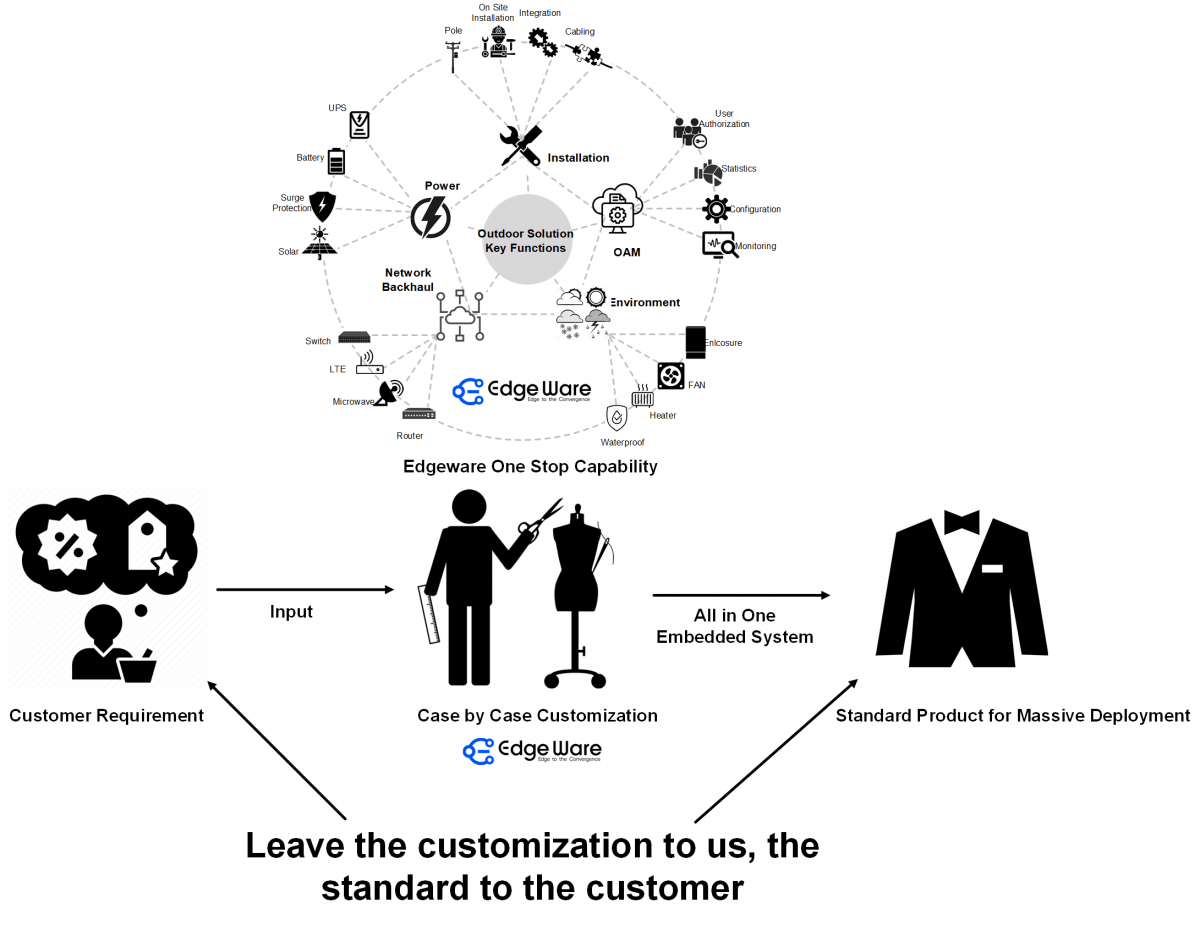
The above picture reflects the design philosophy of Edge Span, namely:
Leave the customization to us, the standard to the customer.
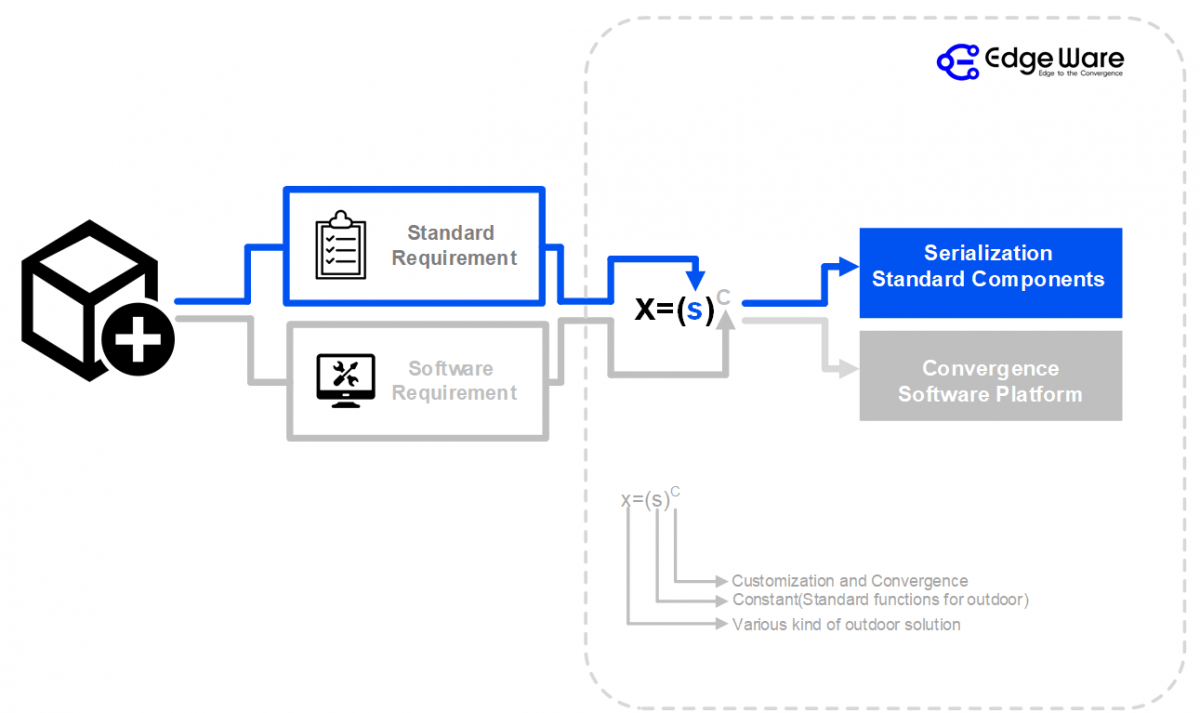
Edgeware has a full set of capabilities for network, power, software and structure, and can be customized for the customer’s case by case, not limited to the outdoor cabinet form. It goes a step further and makes the customer-customized model into a standard box form that is easy to deploy on a large scale. This is the overall design concept of Edge Span.
5.3. Architecture of Edge Span U Series
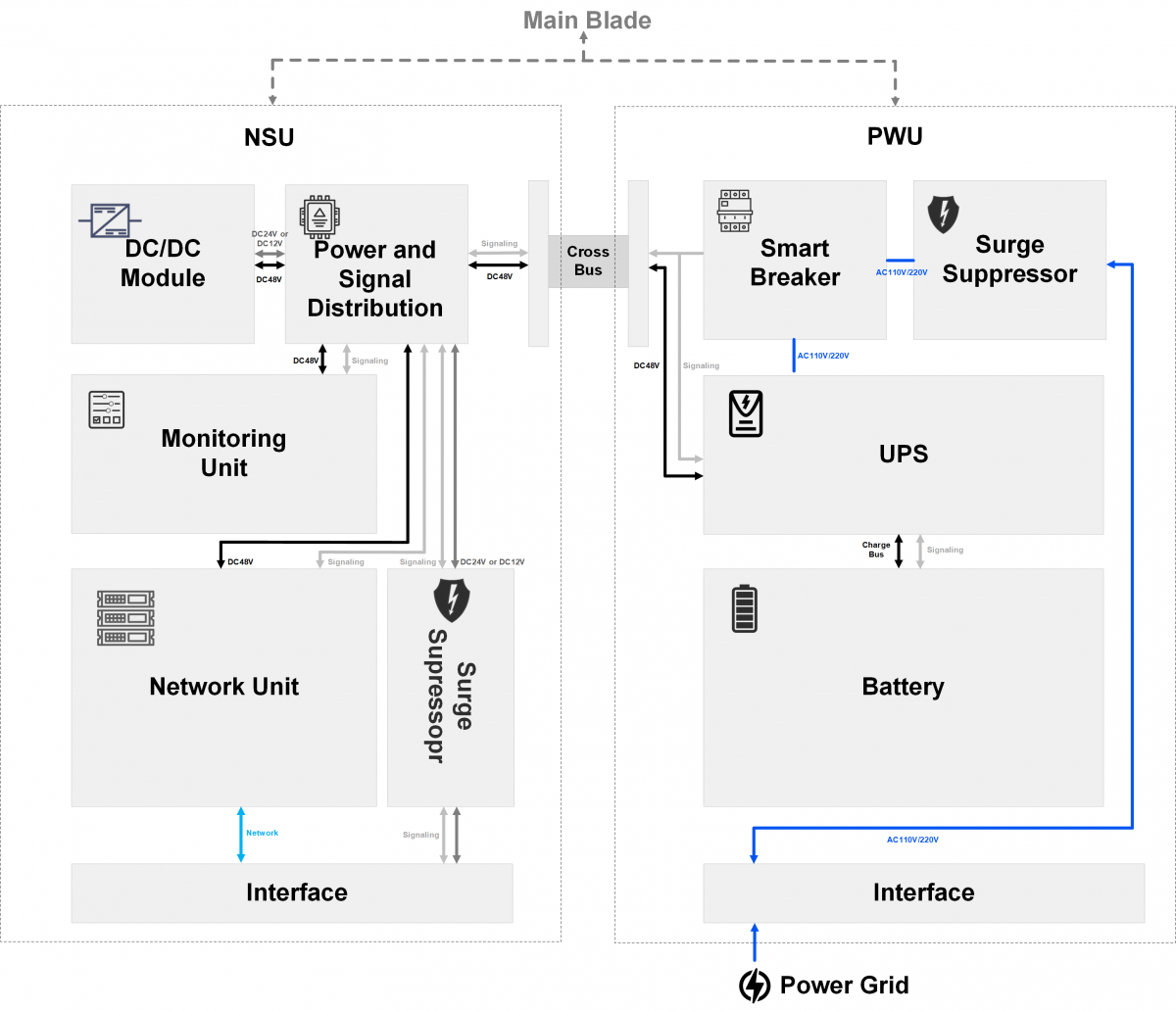
As you can see, it is a small but complete solution. We tried to put all the outdoor UPS system needed functions into one box as well as the monitoring and network modules. There are many challenges especially heat dissipation, but we overcome it. This is our series product:
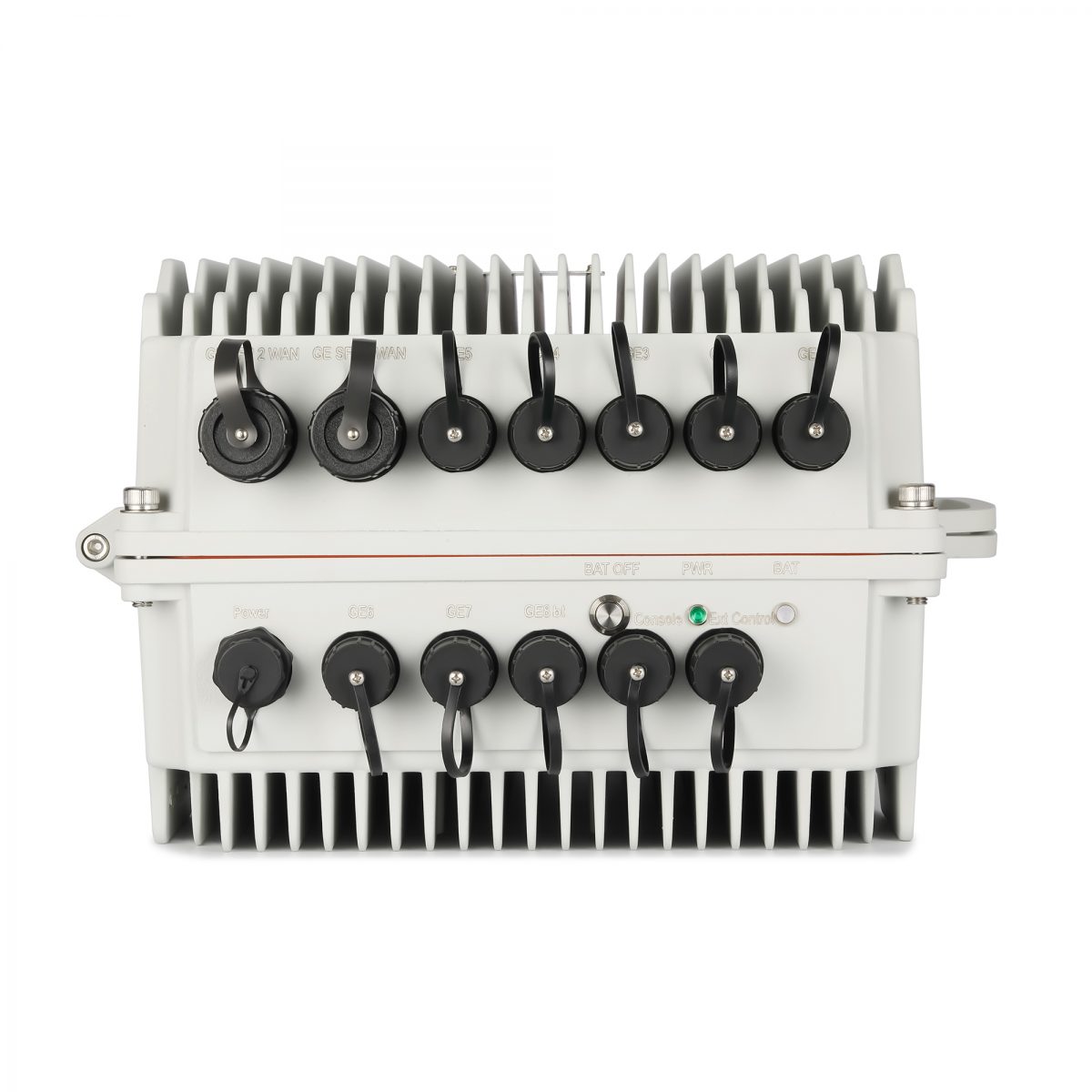
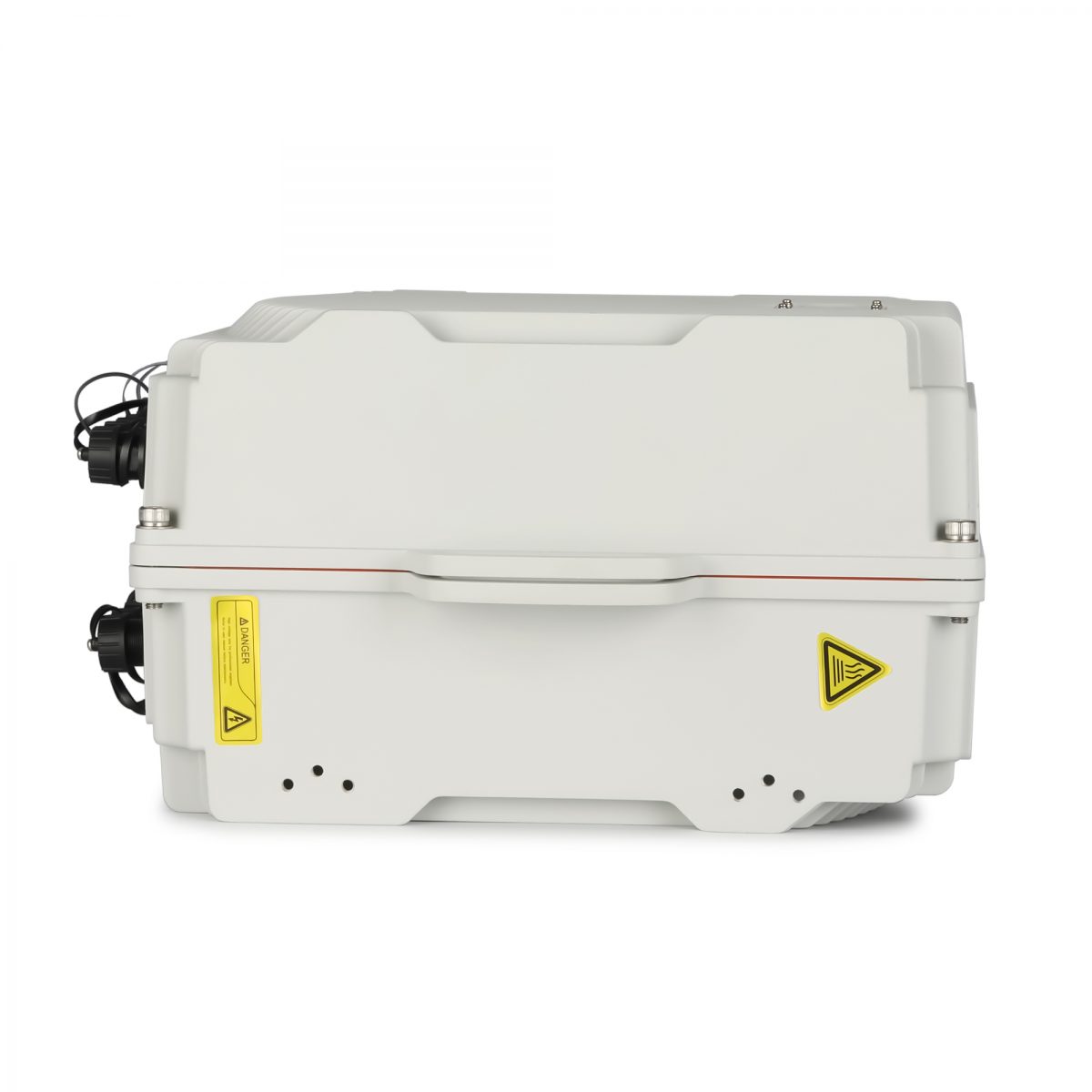
All in One Outdoor UPS System-Edge Span U200-LSP 200W/300w with POE Switch Battery
Edge Span U200-LSP Specification | |
Dimension | W*H*D 295mm*355mm*214mm |
Weight | 13.5kg(with all system) |
Material | Aluminum |
Ingress Protection | IP65 |
Heat Dissipation | No fan design, natural heat dissipation |
Protection | Smart breaker with over-voltage under-voltage over-current protection, embedded with surge suppressor |
DC-UPS | Rated Power 200W Input 110V/220V 50/60Hz Output 42.00-58.00VDC |
Battery | 48V4.8AH or 48V9.6AH Lithium Battery |
Network Module: | Layer 2 switch with Downlink 6-8*GE ports RJ45, uplink 1-2*GE ports RJ45/SFP optional. Ports can be customized. |
PoE: | Downlink ports support 802.3 at/af, max PoE power 180W when configured with 200W DC UPS, 240W when configured with 300W DC UPS 802.3 bt 60W POE module optional. |
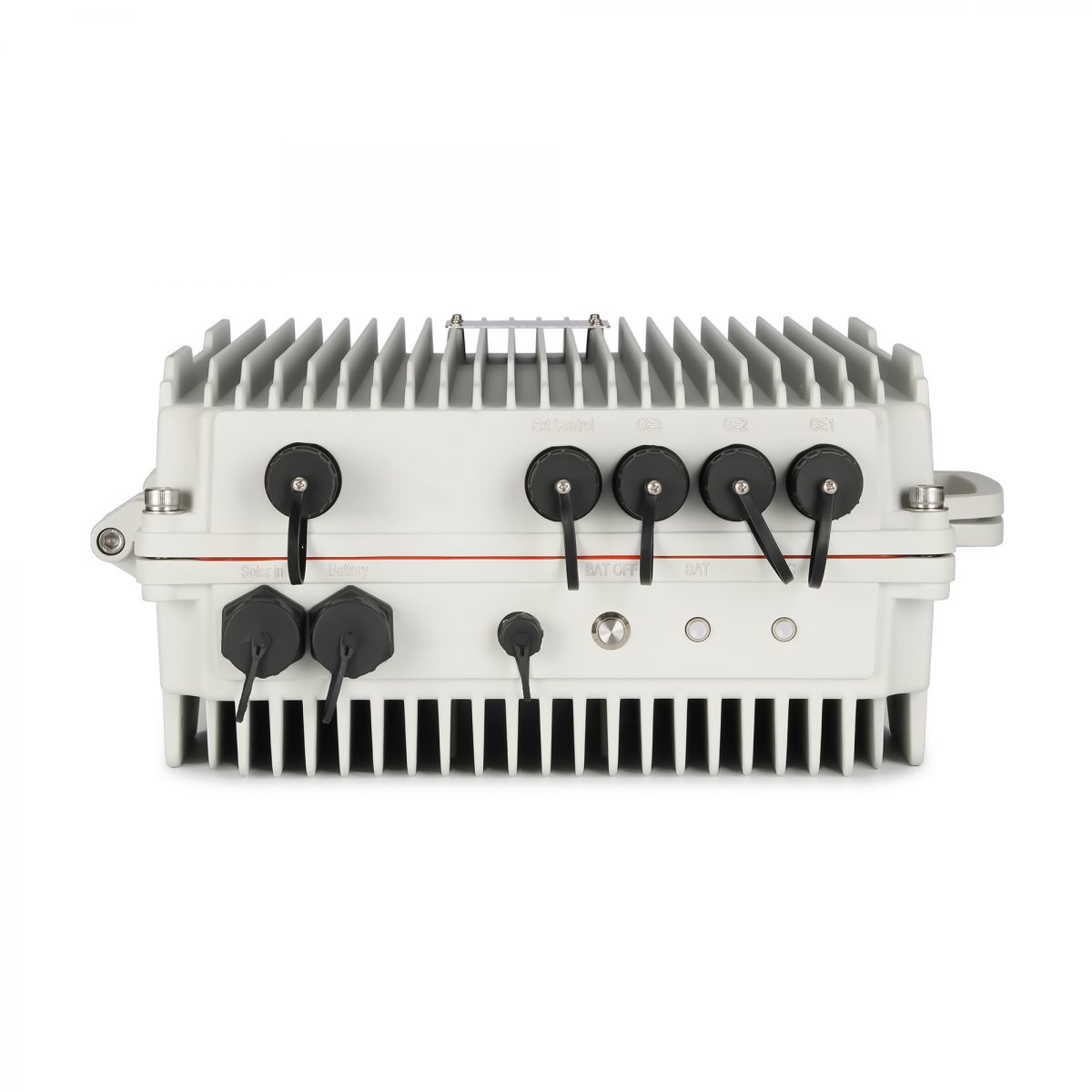
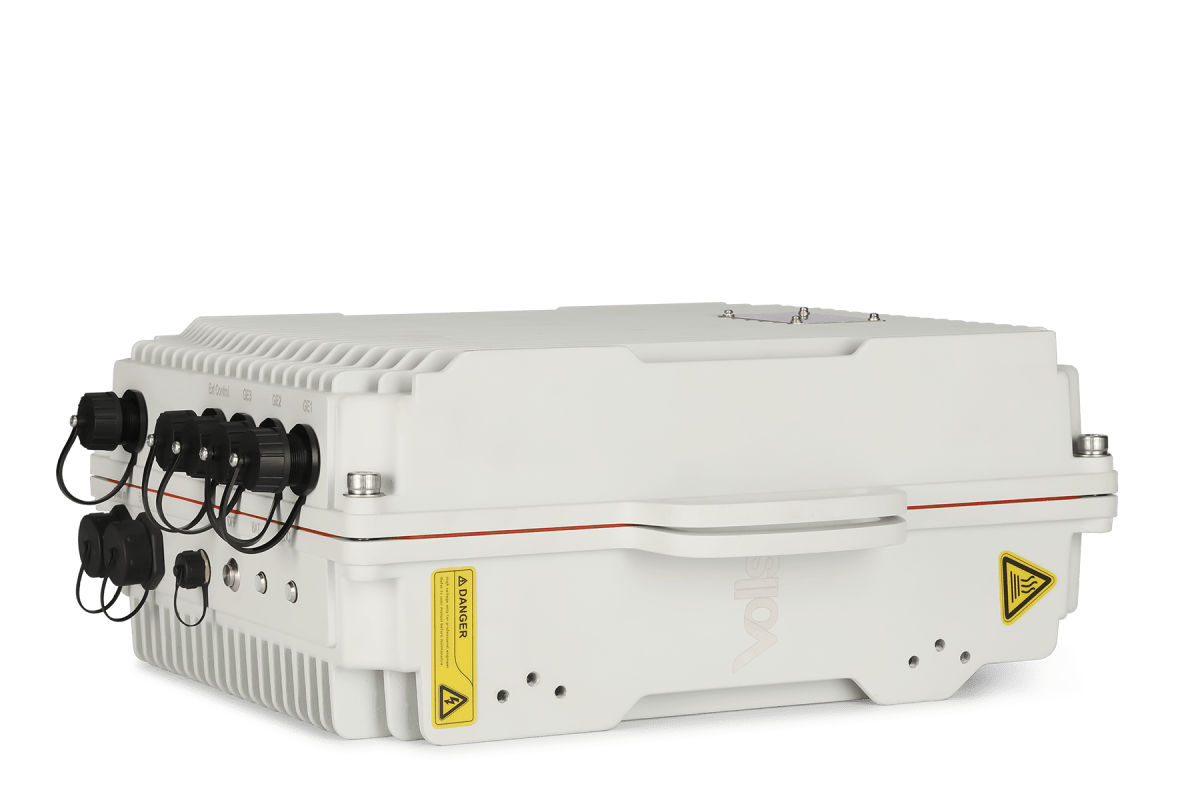
All in One Outdoor UPS System-Edge Span U60-LSP 100W with POE Switch Battery
Edge Span U200-LSP Specification | |
Dimension | W*H*D 295mm*355mm*150mm |
Weight | 8.5kg(with all system) |
Material | Aluminum |
Ingress Protection | IP65 |
Heat Dissipation | No fan design, natural heat dissipation |
Protection | Smart breaker with over-voltage under-voltage over-current protection, embedded with surge suppressor |
DC-UPS | Rated Power 100W Input 110V/220V 50/60Hz Output 42.00-58.00VDC Output 12VDC |
Battery | 48V4.8AH Lithium Battery |
Network Module: | Layer 2 switch with Downlink 4*GE ports RJ45, uplink 1-2*GE ports RJ45/SFP optional. Ports can be customized. |
PoE: | Downlink ports support 802.3 at/af, max PoE power 80W 802.3 bt 60W POE module optional |
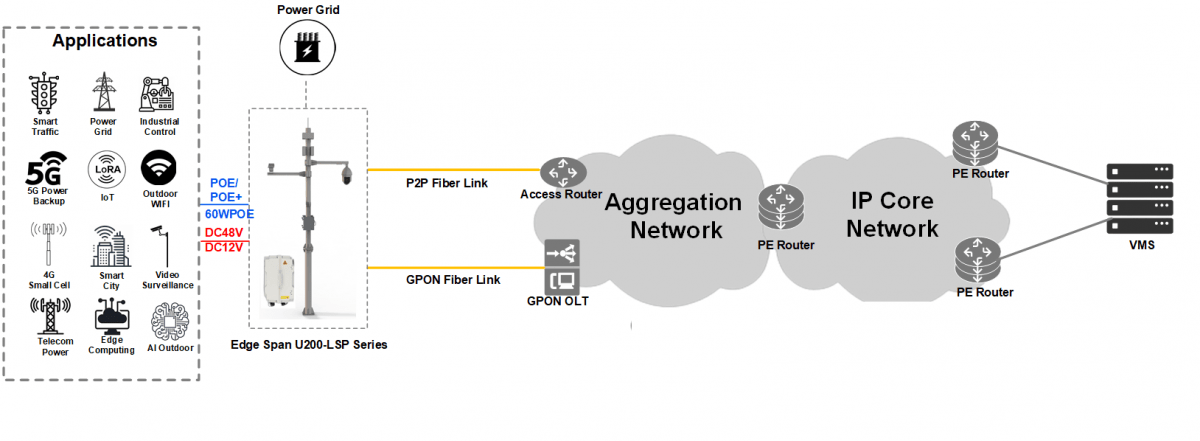
Edge Span U200/60-LSP Applications
5.4. Edge Span Series Advantages
Edge Span is the true All in One Outdoor UPS. We integrate all the functional units you need to deploy at the outdoor edge node to achieve miniaturization. Its advantages are as follows:
(1) Miniaturization
The miniaturization of the whole system makes the deployment simple and easy. The general weight of the whole machine is 8-13.5kg, which is far lower than the cabinet-type equipment of the same level.
(2) Plug and Play
The system is simple and easy to operate, realizing a real plug and play. After the hardware installation is completed, the power-on and start-up can be completed in 2 minutes, no complicated configuration is required, and no complicated cable interconnection functional units like outdoor cabinets are required.
(3) Super Protection
The whole system has a cast aluminum housing with strong corrosion resistance. The protection level of the whole system reaches IP65, IK08. It is especially suitable for deployment in the wild with harsh environment, such as desert, rain forest, seaside and other special environments.
(4) Maintenance-free
Because the system uses an aluminum casing for natural heat dissipation, the fan is eliminated. As a result, the operation of the whole system does not require maintenance at all. And all the core components are industrial-grade, designed for deployment in complex outdoor environments.
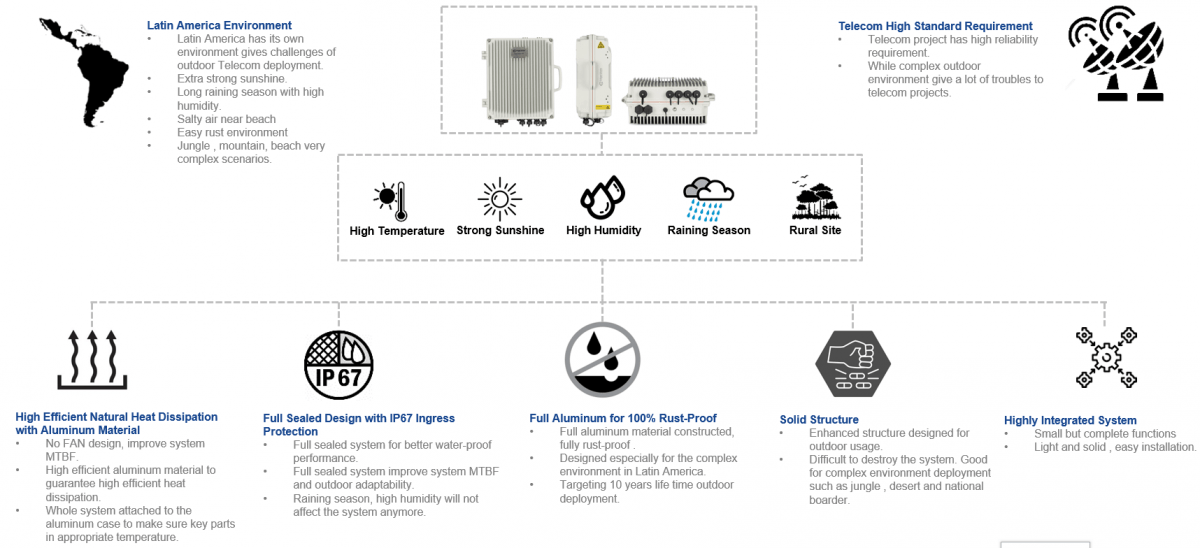
(5) Complete network modules for selection and customization
Edge has a full set of network modules for customers to choose and customize. We tailor it for you according to your scenario. When you receive the device, it will be a standard product that can be deployed at any time.
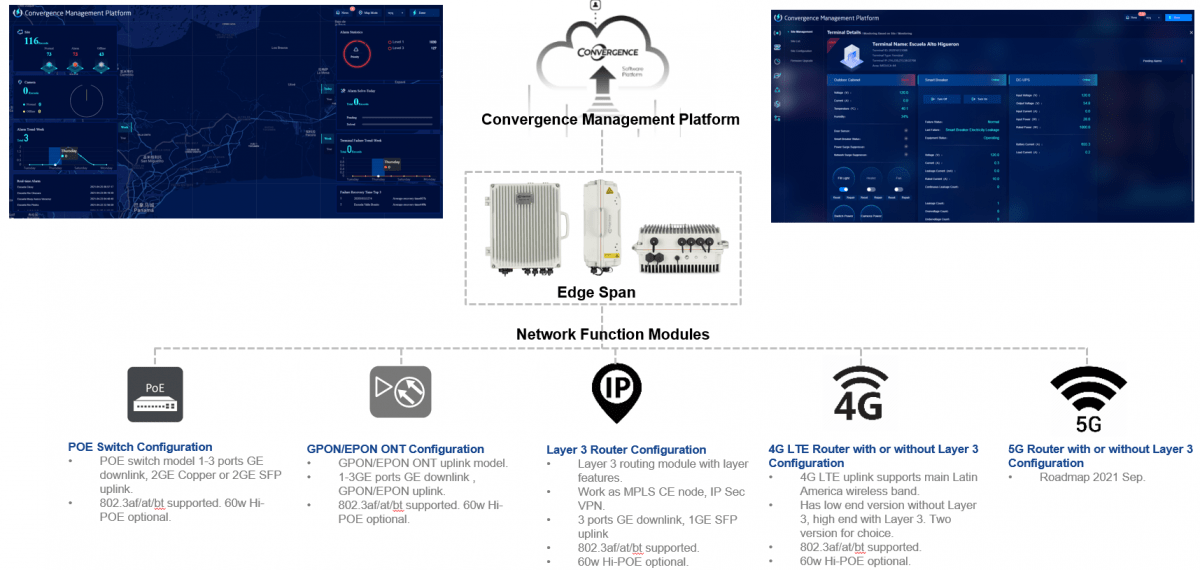
Video: Edge Span Network Modules
Video:The reason uses aluminum enclosures
6. Summary
Although the evolution of our All in Outdoor UPS can help customers carry out one-stop deployment in most outdoor edge networks. However, this does not actually solve all scenarios. Most importantly, we found that there are many scenarios where utility power cannot be obtained at all. For such scenarios, we have also developed various models of All in One Solar System. For example:
Solar Plant Edge Computing with POE Switch
Solar Plant Edge Computing with LTE/5G Uplink
Remote Solar System with POE Switch
Solar Battery Enclosure with LTE/5G Uplink
We will introduce them to you in other blogs.
Reference
Lorem ipsum dolor sit amet, consectetur adipiscing elit. Ut elit tellus, luctus nec ullamcorper mattis, pulvinar dapibus leo.
Commercial successes in power storage B. Roberts; J. McDowall
https://ieeexplore.ieee.org/abstract/document/1405867
Energy storage applications for large scale power protection systems B.P. Roberts
https://ieeexplore.ieee.org/abstract/document/971422
Evaluation of cooling solutions for outdoor electronics Mahendra Wankhede; Vivek Khaire; Avijit Goswami; S. D. Mahajan
https://ieeexplore.ieee.org/document/4451770
Implementation of a Low-Cost IoT Enabled Surveillance Security System Salman Hassan; Safioul Bari; A S M Muktadiru Baized Shuvo; Shahriar Khan
More Topics
Edge Span S60-5GPS All in One Security Camera Solar Power Supply and IoT Solar Power
The post explained what is Edge Span S60-5G Solar Battery Enclosure and its features
Why does Wi-Fi for rural areas coverage require a one-stop solar solution?
How to build Solar power system for Rural WIFI
Edge Chain U1000-AC High Temp UPS Designed for Outdoor Cabinet
The post explained what Edge Chain High Temperature UPS
Edge Chain U300 High Temperature UPS Designed for CCTV Cabinet
The post explained what Edge Chain High Temperature UPS
How to implement one-stop deployment of IEC101 IEC104 gateway indoors and outdoors
Edge Span S60 Series All in One Solar Power Supply Designed for Solar Panel for CCTV
Edge Span S60 Series All in One Solar Battery Enclosure Outdoor Designed for Solar Panel for Security Camera
Edge Span S60 Series All in One Solar Power Supply Designed for Solar Panel for CCTV

